INTRODUCTION
Stingray Sunset
It’s said that Zora Arkus Duntov – the first Chief Engineer and “Godfather” of the Corvette – preferred the responsiveness of the lighter high-output “road circuit” oriented small-block Sting Rays to the heavier big-blocks.[1] He was after all a LeMans 1.1 liter (67 cubic inch) class winning driver for Porsche in ’54 and ‘55. As custodian of Ed Cole’s high-performance small-blocks, Duntov had overseen fuel injected 327s and solid lifter 350s that – at about 330 net horsepower – could rival big-block power.[2] Yet after his retirement in 1975, he finally purchased a Corvette, a 454 cubic inch metallic blue ’74 LS4 big-block.[3]
With propulsion options pruned by regulation, piloting the last big-block was perhaps a pragmatic way of convincingly riding off into the sunset. As we covered in parts ‘6A’ and ‘6B’, oil prices had soared from the mid-70s into the 80s. But as long as fuel consumption wasn’t a bother, the 35% torque advantage over the base engine beat waiting until the 90s for the resurrection Corvette’s ZR-1 option. Especially considering that in 1974 upgrading to the “rat motor” only added 5% to MSRP vs. the eventual 70-80% upgrade cost of the C4’s dual overhead cam ZR-1.
Small World, Smaller Share
Certainly as an industry, automobile manufacturers were in greater need of innovative engineering in 1980 than in 1960. US regulation necessitated the development of smaller more efficient cars. If GM could introduce successful pint sized cars – having had mixed results with the Corvair and the Vega – it might continue to dominate a planet that appeared to be running out of oil.
Resourcefully designed and durably built, efficient Japanese vehicles had moved from relative insignificance to command 25% of the US market by 1980.[4] With strong encouragement from Washington – after the Iranian Revolution jolted already volatile oil prices – Detroit priorities finally shifted.[5] GM rushed its small front drive X-body (Citation, Skylark, Omega, and Phoenix) into production as it eyed diversification outside of automobiles.[6] Ford borrowed the name and styling of its compact “Escort” from its division across the pond.[7] And a focused Chrysler wagered $1.5 billion of taxpayer’s money on the K-car.[8]
Lives After GM
As a bystander to GM’s evolution in 1980, Duntov almost certainly had given up on a mid-engine fourth generation Corvette and only hoped that turbos or fuel injection could restore some sporting motivation. Desperate for innovation, it’s surprising that GM hadn’t pursued a consulting arrangement with Corvette’s retired Chief and master powertrain engineer.[9] Instead, with his new found freedom Duntov kept busy with other retainers, such as increasing the “charge density” of Holley’s new “Z” line of V8 intakes.[10] These after-market carbureted manifolds intended to improve fuel-economy and throttle response, but weren’t cut out for the task like his now extinct Rochester fuel injection had been.
As Chief Engineer at Chevrolet, Ed Cole had assigned Duntov to the development of fuel injection in 1955 saying that he “would give his right arm to do [the project] himself.[11]” Twenty years later, after a pair of legendary careers – Cole having been President of GM for nearly a decade – both men were not only retired from GM, but were also uninvolved and discouraged.
Vega Vertigo
After Cole and Duntov’s retirement, GM’s Warren Technical Center was still getting the bad taste out of its mouth from Cole’s Chevrolet Vega. Chevy General Manager John DeLorean and Engineer Lloyd Reuss – who later became GM President – had also led the project.[12]
Even though in base form it was an economy car, the Vega ordeal had been garnished by a fuel injected moonshot with motorsport focussed Cosworth in Northampton, England. Having only sold 3500 of the 5000 planned upmarket Cosworth powered hot-hatches in ’75 and ’76, the bow tie was left holding a proverbial “bag” of 1500 hand-built 16 valve 2.0 liter aluminum engines.[13]
But the extra inventory was a small cost compared to the disarray left by labor’s “Lordstown Syndrome”[14] and management turnover that fueled competitors, such as Delorean Motor Company.[15] By 1980, only Reuss remained at GM; and he then headed Buick.
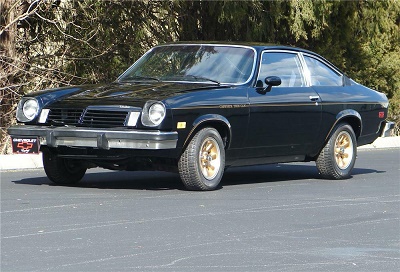

A 1975 Chevrolet Cosworth Vega with a hand-built DOHC 2.0 liter port fuel injected four cylinder and 16 valves. Only 3500 sold in 1975 and 1976. Photo courtesy of Barrett-Jackson Auction Company
Stingray Suppression
So Corvette development soldiered on with carbureted manifolds. Even as Cadillac’s new middleweight Seville substantially reduced emissions and improved fuel economy[16] by including standard electronic port fuel injection starting in the ’76 model-year.[17] In fact, by 1978 all gasoline powered US Sevilles – from Augusta to Pebble Beach – had received identical 180 horsepower engines that met California air quality requirements. Even more surprisingly in 1978, Seville owners on California golf courses could boast five more horses from their 350 cubes than interlopers packing clubs in Chevy’s two-seater.


A 1976 Cadillac Seville having a 350 cubic inch Oldsmobile Rocket V8 with Bosch/Bendix port fuel injection and 180 net horsepower. Introduced in 1975 and offered from the 1976 through 1979 model-year. Photo courtesy of Barrett-Jackson Auction Company
Watching Chevrolet from the sidelines, Duntov might have felt like his child was taking the ball the wrong way down the football pitch. The big-block – which originally “displaced” fuel injection in 1965 – hadn’t been available in the Corvette for five years. And still, due to Management’s resistance, high-performance fuel injection had not been resurrected. But Duntov remained so adamant about pushing Corvette’s technical envelope that – even after his retirement – he made his endorsement of an aftermarket boutique’s limited edition C3 series contingent on the incorporation of turbo charging technology.[19]
It was of little consolation that in 1981, Chevy released a new L81 engine having a single electronically controlled fuel injector pointing into a carburetor’s wet manifold.[20] These sorts of Frankenstein single point injection systems – eventually designated Throttle Body Injection (TBI) by GM – helped reduce emissions and fuel consumption at idle, but struggled to generate even 200 horsepower. And in 1981, gone were the days when performance oriented buyers could check the L82 box to eke out a little more horsepower and headroom for modifications.
Pushrod Panoply
Finally in the 1985 model-year, the chronic power famine that had taken hold of Corvette in the 70s began to dissipate. A Bosch/Delco “Tuned Port” fuel injected (TPI) small-block – the electronically controlled L98 – complimented the Corvette’s svelte new body 17 months into C4 production. By now it had been almost three decades since Chevrolet first introduced port fuel injection.

Note: Prior to 1972 model year, reported horsepower was “gross” (i.e. engine dyno-ed without intake or exhaust filtration/obstruction); GM’s published ratings of 425-430 hp were disregarded as conservative for the ’65 L78, the ’67 L88 ,and the ’69 ZL1. Instead gross hp of 442, 560, and 600, respectively was derived from the work of Bob Thomas/Ludvigsen, Hot Rod Magazine Testing, and David Kimble, respectively. Results for the L88 and ZL1 assume intended “day 2” tubular header modifications. Gross horsepower was then converted to net using a ratio between 75 and 85%.
Source: Corvette Museum Archives, GM, Noland Adams – Automobile Quarterly, Karl Ludvigsen – Automobile Quarterly, Tom Falconer – Motorbooks, David Kimble – Motorbooks, David McLellan – Bentley, www.hotrod.com/articles/ccrp-0910-chevy-l88-427-engine/ -and- AnotherApex estimates.
And like a seasoned Nashville musician plucked out of rehab, Chevrolet soon promoted Corvette as a “special guest” during large venues with European headliners. This was perhaps premature, as base Corvettes still lacked the power of the Stingrays of the 60s, let alone the manners of old world thoroughbreds.
Zany ZR-1
Nevertheless within a couple years, aluminum cylinder heads debuted on the base L98 and Corvette finally eclipsed the 235 net horsepower last churned out by a base Corvette in 1969, the first year for the 350 cubic inch base engine.[21] But as Japan’s engineering prowess rose like a sun over America, and the C4 matured, Corvette Chief Engineer Dave McLellan pushed powertrain engineers for more horsepower.
Simply turbo-charging the old pushrod small-block – even with its new TPI system – lacked the prestige of competitors’ overhead camshaft engines. And with a growing backlog of TPI-like implementations for other products at the time, GM’s Warren Technical Center lacked the resources to rethink the small-block.[22] Although GM assessed Hessian contractors, Lotus proposed the brand new DOHC mill that powered the performance, panache, and price of the 375 horsepower Corvette ZR-1 in 1990.
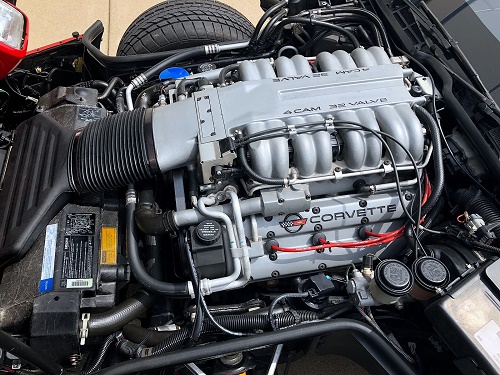

1990 Chevrolet Corvette ZR-1 with a LT5 350 cubic DOHC V8 rated at 375 net horsepower. Pictures courtesy of Corvette Mike Midwest, in Burr Ridge, IL.
When publicized at the Geneva Motor Show in 1989, the ZR-1 cast an immediate halo over Detroit. However, emerging from the Pacific with 300 horsepower later that model-year was the sleek new Nissan 300ZX twin-turbo. At half the price of Chevy’s “King of the Hill,” it was impossible not to be impressed by the 1990 300ZX. GM knew it had to produce an economic alternative to the ZR-1, and fast!
CONTENTS:
ILLUSTRATIVE SUMMARY:
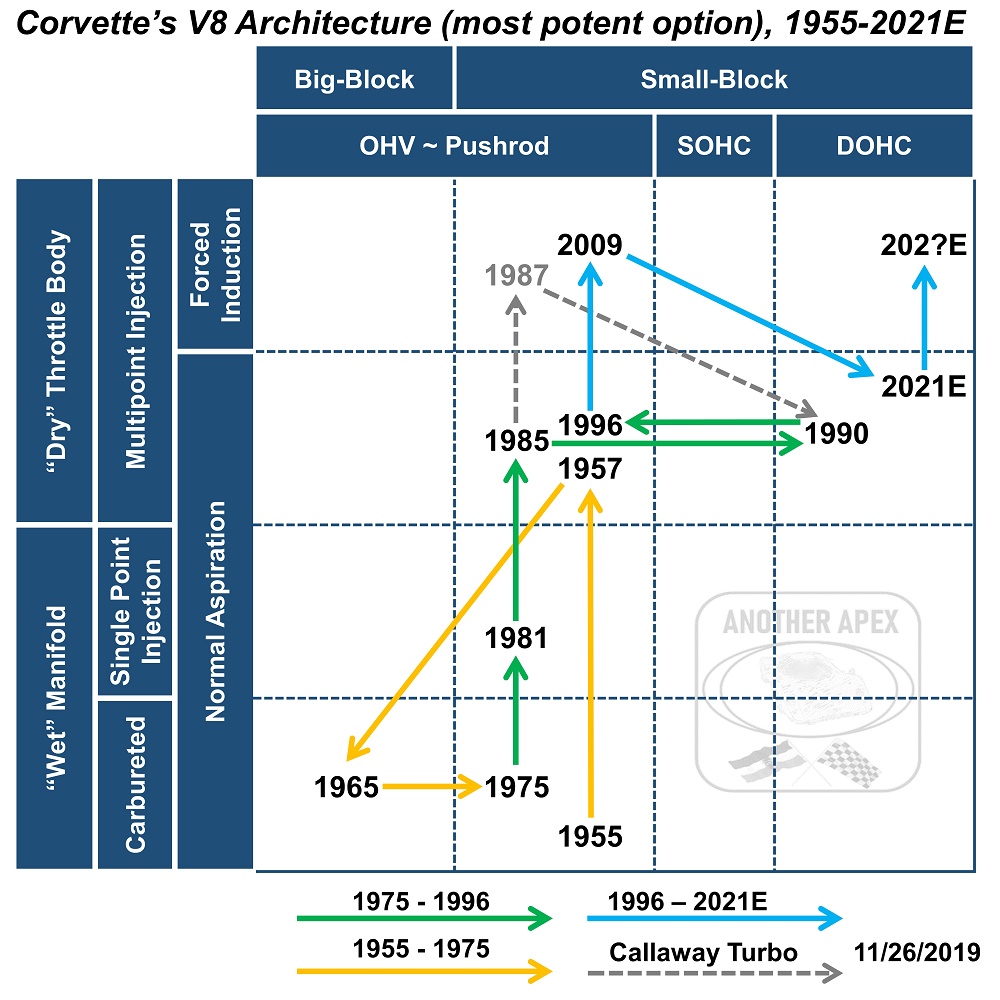

Forced Induction = Turbo or Supercharger
DOHC = Dual Overhead Camshaft (typically 4 valves per cylinder)
SOHC = Single Overhead Camshaft (typically 2 valves per cylinder)
OHV = Overhead Valve (typically 2 valves per cylinder)
Chapter 1: Rochester Fuel Injection (50s and 60s)
Fuelie or Folly
Back when Duntov had worked with John Dolza on the original ‘mechanically’ fuel injected small-block they had emphasized that the real benefit of fuel injection was not peak power delivery but responsiveness, efficiency, and barometric flexibility. In Duntov’s words there was “. . . a spectacular increase in vehicle performance with otherwise identical dynamometer power.[23]” So Chevy had marketed “Ram Jet fuel-injection” alongside ‘jet airplanes’ as a revolutionary efficient technology for future sedans.
“The only way to design a Chevrolet is like buying children’s clothing – one has to allow for growth.”[24] Such was the explanation Dolza and Duntov offered the Society of Automotive Engineers in 1957, when describing the shape of the “dry” intake manifold on their mechanically port fuel injected small-block.
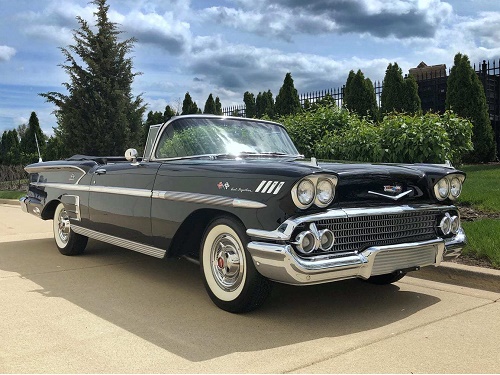
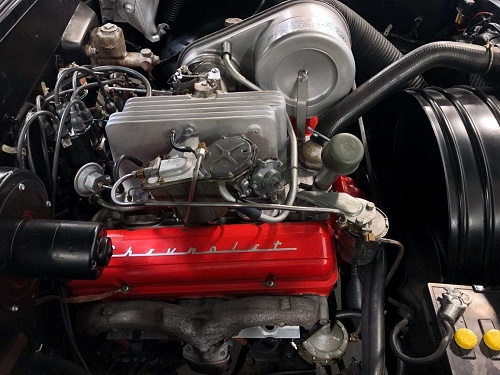
1958 Chevrolet Impala Convertible with a 283 cubic inch small-block V8, “Ram Jet” port fuel injection, and 250 gross horsepower. Pictures courtesy of Corvette Mike Midwest, in Burr Ridge, IL.https://corvettemikemidwest.com/used-corvettes-for-sale/1958-chevrolet-impala-black-convertible-with-fuel-injection/
At that time Chevrolet’s revolutionary fuel injection system had few global rivals. The Mercedes 300 SL Roadster – an obvious fuel rationing alternative in 1957 – cost well over twice as much as a top-of-the-line Corvette.[25] Not even Cadillac – that up until that time had typically paraded GM’s new technology – could compete with the potency of a fuel injected ’57 Bel Air.[26] Indeed, the cheapest Cadillac Coupe cost almost twice as much as a Chevy “fuelie” Sport Coupe. That made the Chevy Bel Air’s 20-30% mechanical advantage seem almost communist.[27] Sure, the Bel Air’s limited edition cousin – the Pontiac Bonneville – could rock 310 gross horsepower with its version of the Rochester fuel injection system, but it weighed 600 lbs. more than the Chevy.[28]
Looking back, Chevrolet wasn’t boasting when it said its 283 gross horsepower Rochester “Ram Jet” fuel injection – at one horsepower per cube – was the “most far-reaching engine improvement in the entire industry.”[29] No, the boasts will come in the next chapter, when Chevy attempted to reintroduce “injection” in the 80s.
Timing is Everything
So grow Chevrolet did, along with the US economy. And in a country awash with natural resources and unlimited emissions, GM soon determined that engine displacement quenched America’s thirst for power more economically than precision fuel delivery. So the optional “fuelie” small-block lasted in Chevy sedans – and a few Pontiacs – only a few years – ‘57-‘59.[30]
In fact, due to their limited adoption, GM’s Ram Jet fuel injection remained a nascent and relatively expensive technology. Nevertheless, fuel injected small-block Corvettes won classes at Sebring and LeMans, and made a pop culture splash in the Beach Boy’s 1964 song Shut Down.[31]

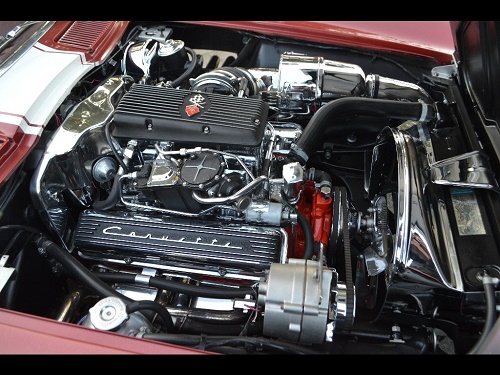
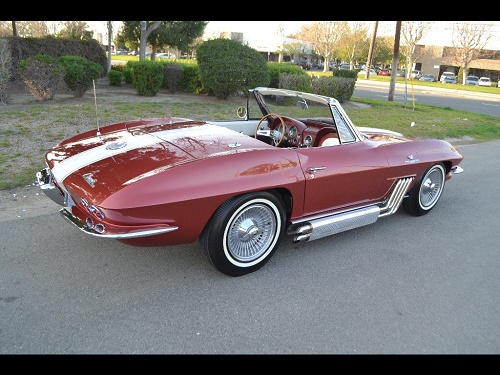
A 1963 Chevrolet Corvette Convertible built for Chevrolet’s then GM Semon “Bunkie” Knudsen. It was a ’63 reinterpretation of the Sting Ray Racer shown at the ’59 New York Auto Show. It’s 327 cubic inch small-block V8 had “Ram Jet” port fuel injection, unique tubular long-tube headers, and 360 gross horsepower. Pictures courtesy of Corvette Mike, Anaheim, CA. Car no longer for sale. Knudsen Car details from Jay Ramey – ‘Autoweek’ accessed 12/7/2019
When Chevy’s 396 cubic inch big-block replaced the Corvette’s fuel injection option mid-way through 1965, only 100,000 fuel injectors had landed in Corvettes. Eight fuel injectors for each of the 12-13K small-block Chevy fuelies installed on about 10% of a decade’s worth of Corvettes.
To put the lack of “fuelie” volume into perspective, in the Model T’s first year of production Henry Ford produced 10,000 cars.[32] And today annual production of 250K cars generally signifies a “high volume” car.[33] By the time Henry Ford exceeded that benchmark in 1915, he was able to cut the Model T’s price in half.[34]
So when the $500 Ram Jet fuel injection option (20% of sedan MSRP) was introduced in 1957 – and Chevrolet produced 1.5 million passenger cars annually – it would have taken only 15% of buyers to gain significant economies of scale and drastically reduce the price of adoption. Yet likely fewer than 3% of Chevrolet’s vehicles in 1957 were optioned with fuel injection.[35]
One Man’s Trash is Another Man’s Treasure
It would be another decade before GM again tested waters with one-off fuel injected models. Regrettably, the first generation Chevrolet “fuelies” often couldn’t be effectively supported in the aftermarket. One auto repair shop replaced at least 40 Ram Jet units with traditional carbureted setups.[36] So uncommon were the engines that, generally speaking, aftermarket mechanics lacked proficiency in the new Ram Jet technology.
So in 1965 – as Detroit’s big-block rivalries raged and Ralph Nader launched his crusade [covered in part 5] – Stuttgart’s Bosch licensed key patents from the Bendix Corporation’s unfinished 1958 “Electrojector” effort with Chrysler.[37] After Bosch revamped the design with modern electronics, Volkswagen cut the ‘per system’ cost by deploying their “D-Jetronic” fuel injection in European four-cylinder applications.[38] Not only did these smaller cars require half the fuel injectors of a typical American V8, but they also were sold in higher volumes and therefore generated more economies of scale. Indeed, by 1970 Volkswagen produced 272,031 of their model 1600 globally, with standard fuel injection on those destined for the US.[39]
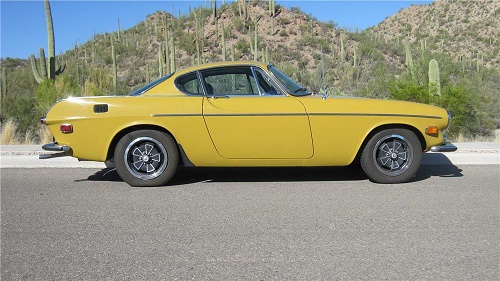
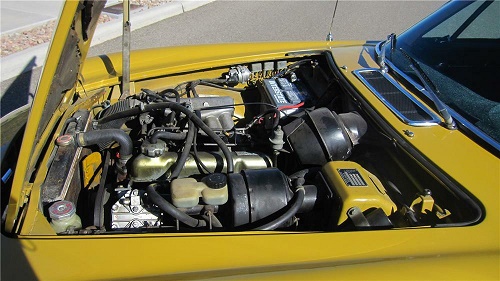
1971 Volvo 1800 E with Bosch D-Jetronic port fuel injected 130 horsepower 2.0 liter four-cylinder. Hagerty noted that Volvo advertised the P 1800 as “. . . either the world’s fastest, prettiest truck, or the world’s toughest, most reliable sports car.” Photo courtesy of Barrett-Jackson Auction Company
Chapter 2: Caught in the Cross-Fire (70s to early 80s)
Picking up the Piece(s)
Of course the regulation that ignominiously followed the demise of GM’s mechanical fuel injection in ’65 ultimately made auto manufacturers accountable for fuel economy and emissions. Metrics that weren’t helped by big-block engines and, in fact, could have been addressed with fuel injection.
Indeed, in 1957 Dolza had told the Big Three’s Detroit engineers “A fuel system capable of correcting even 50% of the average carburetor deficiencies may produce a 10% improvement in fuel economy.” Dolza continued “The possibility of exhaust free from hydrocarbons and fuel system evaporation would greatly help in an important phase of reducing air pollution.[40]” Not even two decades later, spurred by regulatory demand from the US, Bosch and its European partners – like VW and Volvo – gradually overcame the headwinds of fuel injection’s mass adoption in the early 70s.[41]
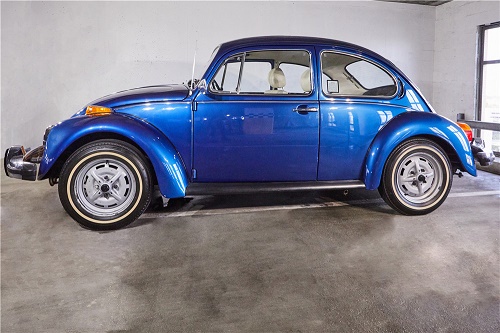
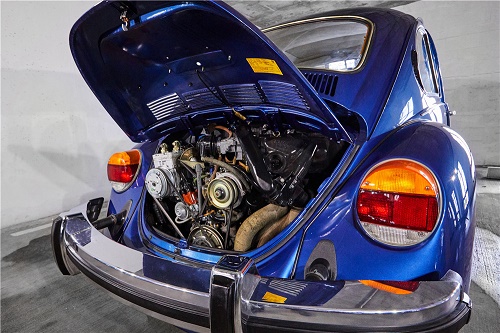
1977 Volkswagen Beetle with a 1.8 liter Bosch D-Jetronic port fuel injected four-cylinder with 50 horsepower. Photo courtesy of Barrett-Jackson Auction Company
As a result, in 1981 it was somewhat ironic that – in miserly desperation – GM lobbed a single fuel injector into the same basic Sting Ray chassis that – a generation before – shot eight injectors and had the Beach Boy’s musing about its potency. Indeed, calling ’81 to ’84 Corvettes “fuel injected,” was about as accurate as referring to them as “corn injected” due to the trace amounts of ethanol that began showing up in gasolines at this time.[42]
Despite being “whet” by an injector [or two], these early 80s intake manifold still functioned about the same as those on Ed Cole’s original 1955 carbureted small-block.[43] As a byproduct its shape, the manifold passively dispersed a mist of air/gasoline in such a way that each intake valve could – when required – load its cylinder. So called single point injection – or TBI – was an inexpensive but obsolete method for priming, when compared to the ’76 Cadillac Seville’s Bosch/Bendix based port fuel injection.
In so called “multi-point” or “port” systems – like the Cadillac’s – only air passed the throttle blade because fuel is deposited in close proximity of each cylinder’s valve by a designated injector.[44] One injector for each cylinder’s intake runner, or port; just like Chevy’s original Rochester mechanical system.
Although Chevy had considered modernizing Duntov’s old Ram Jet system – or borrowing Cadillac’s newer Bosch based system – then Engineering Director Bob Stempel [later GM’s Chairman] dragged his heels.[45] So with greater fanfare than 1981’s L81, GM added a second injector to the 1982 “wet” manifold system and branded it “Cross-Fire Injection.” As a result, off-the-shelf precision port fuel delivery technology skipped the ’81-’84 Corvettes, Z28s, and Trans-Ams, and yet another PTSD trigger phrase landed in VFW vernaculars.
The Difference Between Single Point Injection (GM’s Cross-Fire) and Port Injection (GM’s Tuned Port Injection):
Single Point Injection (SPI) – This method of fuel injection utilizes an intake manifold very similar – if not identical to – those used in carbureted systems. Just as a carburetor sends fuel to multiple cylinders from a single point, so too does SPI. Typically a single electronically actuated fuel injector will feed an air/fuel mix through a throttle blade. But in cases such as GM’s V8 Cross-Fire injection, two electronically controlled injectors feed two separate single barrel throttle blades. GM refers to their SPI systems – with either one or two injectors – as “Throttle Body Injection.” Although the electronics give SPI greater control and efficiency than a carbureted system, the drawback of cylinder to cylinder variation in air/fuel mixture remains. In other words, as both SPI and carbureted systems rely on so called “wet” manifolds, sometimes a cylinder might receive a richer or leaner air/fuel mixture than adjacent cylinders. The significance of the imbalance can vary based on throttle application as well as operating conditions. Nevertheless, SPI systems offer some benefits over legacy carburation and are generally more accessible for maintenance and modification than port systems.
Port Injection – So far, port fuel injection is the most common method of fuel delivery in the 21st century. At least for gasoline injection systems. It is sometimes referred to as multipoint fuel injection (MPFI) as it differentiates from so called “single point” systems through reliance on “multiple” fuel injectors. In port – or multipoint – injection systems, every cylinder has its own designated fuel injector. That injector is typically perched above, or near, the intake valve along the intake runner – or port – that flows from the air intake. Due to the injector’s downstream location – corresponding to its close proximity to the cylinder – the throttle blade does not encounter any fuel, only air. Additionally, the fuel delivered to each cylinder can be precisely measured and controlled by each injector. This results in very little – if any – cylinder to cylinder variation during proper function. When combined with equal air flow – through balanced intake runners – and air flow sensors – port injection provides tremendous control, responsiveness, and efficiency. However, the increased componentry can increase complexity and cost, relative to wet manifold systems.
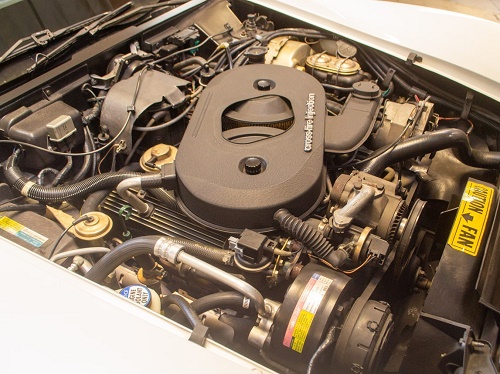
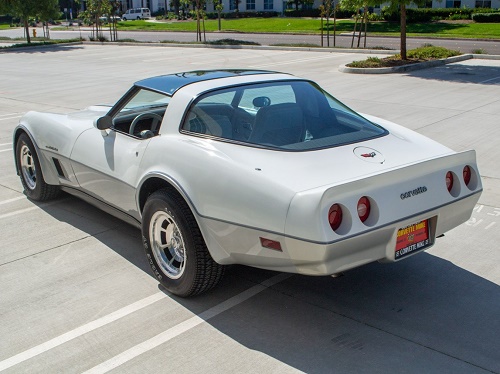
1982 Chevrolet Corvette with standard “Cross-Fire” injection [GM’s throttle body injection] on its 350 cubic inch 200 horsepower V8. Pictures courtesy of Corvette Mike, Anaheim, CA.
Reducing Emissions with Smoke in Mirrors!
Despite extoling the virtues of the new Cross-Fire Injection engine and its 7000 RPM capable tachometer, the sales brochure doesn’t mention the 5200 RPM redline that rendered a quarter of the 1982 Corvette’s tach basically superfluous.[46] What’s more, Chevy seemingly left out the peak horsepower capabilities of the 5.7 liter L83 and its “Cross-Fire Injection with dual throttle body fuel injectors,” as marketed in the brochure.
It took the most devout of technophiles not only to determine the system was architecturally inferior to the Beach Boys’ “fuel injected Sting Ray,” but also to estimate the new engine’s peak horsepower. Hidden within a corner chart of Chevrolet’s sales brochure, browsing engineers could follow RPMs up to a peak of 4200 where in fine print they might deduce that the L83 was producing only 200 horsepower [47] 10% less than the L82 option only two years prior. See the page below.


The 200 net horsepower rating of the new cross-fire injected L83 was hard to find in Chevrolet’s 1982 Corvette sales brochure; the data resided in a corner chart and its fine print. Page and chart presented with permission from GM Heritage Center.
As far as the 1800 tachometer turns available beyond redline – basically unusable instrument resolution – we’d like to assume that Chevrolet meant to save hot rodders the effort of changing the instrument cluster when they added a higher revving engine. But then we realized the complimenting speedometer topped out at the 85 mph then proscribed by NHTSA.[48] Recalling similar illusory designs, C7/C8 Chief Engineer Tadge Juechter described the narrow avoidance of an 8000 RPM tach for the C5 – that redlined at 6000 RPM – during a ride with Car & Driver’s Don Sherman in 2014.[49] In this exchange, Juechter points out how off-putting such smoke-in-mirrors designs can be to customers.
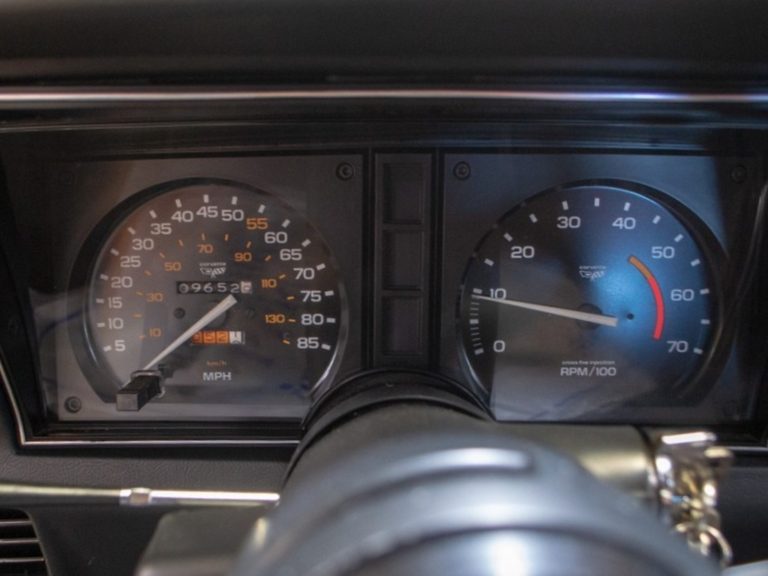
1982 Chevrolet Corvette 7000 RPM tachometer with 5200 RPM redline and government mandated 85 mph speedometer. Pictures courtesy of Corvette Mike, Anaheim, CA.
Without a doubt there was less performance for Detroit’s preeminent GM marketing team to market in 1982. As a result, skeptics might have argued that Corvette’s ‘82 advertising was somewhere between delusional and narcissistic. So while a retired and concerned Duntov lent his name to the aftermarket to ensure that some Corvettes leveraged nascent [turbo] engine technology, Chevrolet’s ’82 Corvette brochure emphasized a “. . . space age standard of fit and finish” and a “standard” four-speed automatic transmission.
The automatic trainy would have been more completely described as the “only” transmission available in 1982. And “fit and finish” was as subjective and controversial as the “New” Coke recipe would be a few years later.[50] However, on showroom floors and inside GM’s top-secret [competitor] Vehicle Assessment Center the “fit and finish” benchmark wasn’t a 1977 Corvette; it almost certainly was the Datsun 280ZX or the new Mazda RX-7.[51] Indeed, Datsun’s Z car had become hugely popular in the US and GM surely was interested in Mazda’s new rotary RX-7. If for no other reason than GM had apparently dropped its own plans for a rotary powered Corvette in 1974 [the mid-engined XP-897] around the time that Mazda got serious about using its Wankel in the 1978 RX-7.[52]

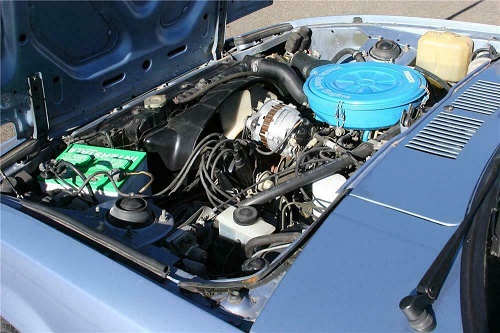

A featherweight 1983 Mazda RX-7 with a 1.1 liter Wankel rotary engine and about 100 net horsepower. The RX-7 was first offered in 1979. Chevrolet considered a mid-engine rotary Corvette but dismissed the idea in 1974. Photos courtesy of Barrett-Jackson Auction Company
Chief Engineer Dave McLellan cathartically acknowledged the mirage of GM’s public messaging at the time in his wonderful book ‘Corvette from the Inside.’ When explaining the General’s modest 1982 power increase McLellan notes that Chevrolet’s exaggerated marketing pointed to the new injectors and – paradoxically – the new low-rise “racing” intake manifold.[53] In retrospect, McLellan explained that the L83’s 5% horsepower boost came in spite of the new Cross-Fire system and actually resulted from catalytic converter refinements. Contrasting the new system with “high-rise” carbureted manifolds – which generally improve fuel distribution and are used in some high-performance applications – the L83’s hood hugging manifold managed to fit the C4 prototypes then in final testing. However, the resulting “low-rise” manifold so poorly distributed fuel that each cylinder’s allocation varied by more than 10%.[54] “We had to compensate with extra fuel [in tuning the L83],” McLellan said.
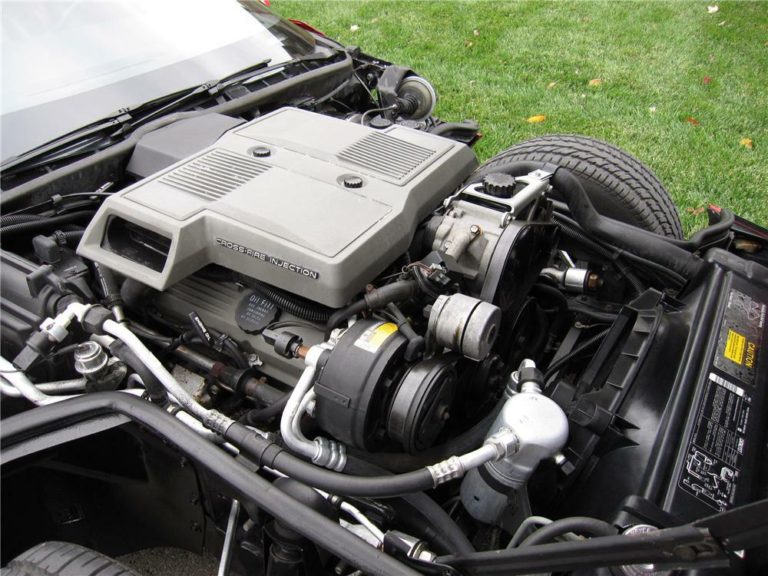
The fourth generation Corvette “C4” was introduced in 1984 with the same Cross-Fire injected – or single point injected – L83 350 cubic inch V8 as used in 1982, except 1984’s bumped by 5 hp to 205 net horsepower. Photo courtesy of Barrett-Jackson Auction Company
Chapter 3: Rehab & Real Horsepower (late 80s)
The Triage of Performance
Originally slated for a 1983 model year introduction, delays pushed the fourth generation Corvette to 1983-1/2 so the model-year was rounded up to 1984.[55] As a result, the stunning new C4 officially hit showrooms in the spring of 1983. Its L83 engine – still at 350 cubes – posted 205 horsepower, only 5 more than the Cross-Fire’s first edition in 1982. However, as a full package the initial 1984 C4 offered dramatically improved performance over the 1982 C3. The progress resulted from significant weight loss and aerodynamic and transmission improvements. Although power remained well under levels from the 1960s, enthusiasts rejoiced at the returned availability of a manual transmission.
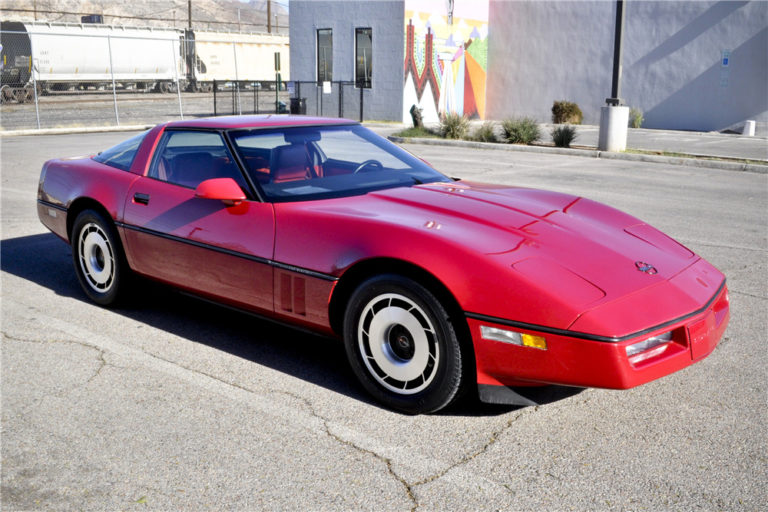
The fourth generation Chevrolet Corvette “C4” was introduced as a 1984 model-year vehicle in early 1983 and continued to include the L83 engine that was introduced in 1982. Photo courtesy of Barrett-Jackson Auction Company
Finally in the 1985 model-year – about a year and a half after C4 began delivery – the chronic power famine that had taken hold in the 70s began to dissipate. This time the “catalyst” really was the electronically controlled L98 350 engine, not the catalytic converter like in ‘82. The L98 finally debuted a Bosch/Delco fuel injection system officially dubbed “Tuned Port Injection” (TPI). After being pushed into obscurity by the big-block 20 years before, a port injected small-block Chevy was back thumping the pavement with 230 horsepower.

The elegant L98 version of the small-block 350 – introduced in 1985 – finally brought port fuel injection back. It’s snappy 230 net horsepower marked the return of real performance to Corvette as well as the F-body GM cars.Photos courtesy of Barrett-Jackson Auction Company
Within a couple years, aluminum cylinder heads arrived on the base L98. A treat that in the past had only been allocated to the mightiest big-blocks, like the L89, L88, and LS6. Now entry level Corvettes had this weight saving feature, and finally exceeded the 235 net horsepower last churned out by the original base four-barrel 350 in 1969.[56] In fact, at 240 horsepower the ’87 base Corvette equaled the horsepower of the ’57 Corvette’s top “airbox” mechanically injected engine.[57]
With the score finally cleared, it was almost like Pete Mitchell [a.k.a. Maverick, in the 1986 blockbuster Top Gun] had finally cleared his family’s military reputation and aimed to be a trainer for General Motors. However, although Stuttgart’s Bosch had rekindled capability in the base Corvette, high-output engine upgrades – like 1957’s airbox fuelie – still hadn’t returned to the menu. But rumors suggested that that might eventually change.
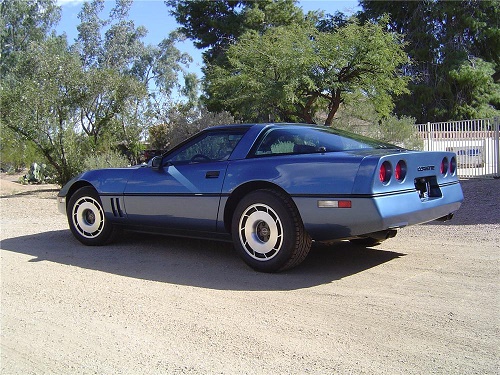
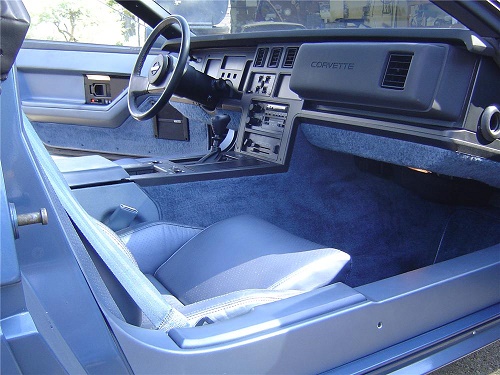
The ’85 ‘Vette had mostly the same sleek C4 body as the prior year when in was introduced. The real change was under the hood. Port fuel injection had finally returned; last installed on a Corvette in 1965. Photos courtesy of Barrett-Jackson Auction Company
The Okay Coral
With pent up demand for real performance, Chevrolet pit the 1985 Corvette against English, German, and Italian rivals, brandishing the C4’s new port fuel injected capabilities.[58] GM hired a third party to conduct a showdown in the Arizona desert. When the dust settled, only the Lamborghini’s exotic Countach beat the C4 in both 0-60 acceleration and lateral acceleration performance.[59] But the eccentric Italian – with its aluminum 48 valve V-12 – stickered at four times the price of the functional Corvette.[60] After reviewing USAC’s test, GM published the test results in the advertisement included in the pictures below.
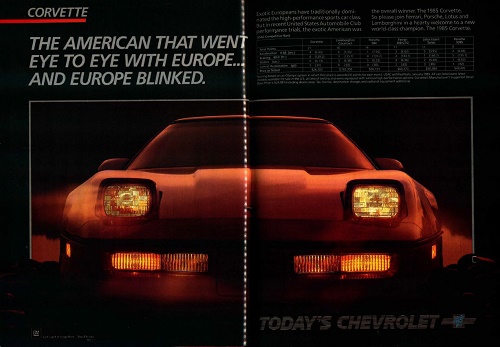
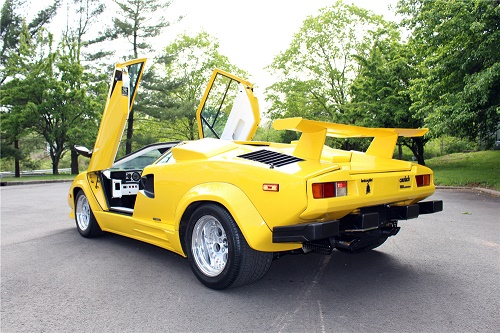
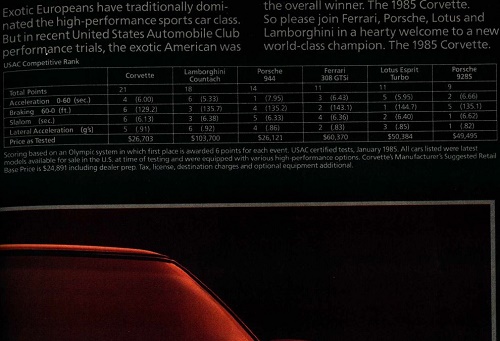
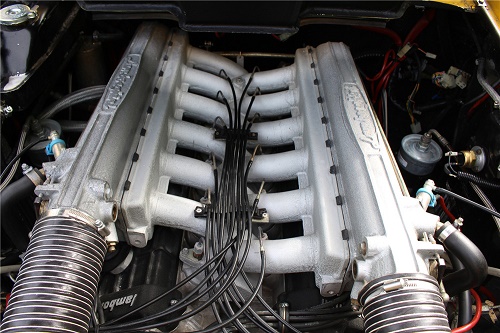
A GM advertisement from 1985 squared the new port injected L98 ‘Vette against a handful of Europeans, including the Lamborghini Countach. The numbers GM disclosed suggested that the Countach led the acceleration tests [0-60 and lateral skidpad], but the Corvette “placed” and the Esprit “showed.” The advertisement concludes: “CORVETTE. THE AMERICAN THAT WENT EYE TO EYE WITH EUROPE. . . AND EUROPE BLINKED.”
In 1985, the Countach rocked a 5.2 liter DOHC V-12 with more than 400 net horsepower; the Lamborghini pictured here is a similar 1988 model-year; courtesy of Barrett-Jackson Auction Company. Advertisement from the July, 1985 magazine Popular Photography pages 40 and 41.
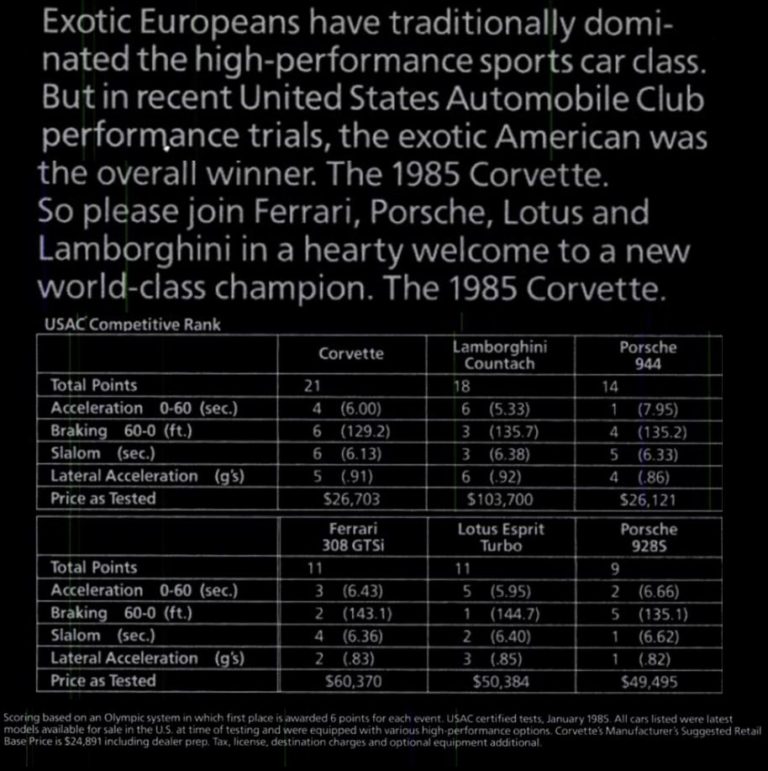
This table is an excerpt from GM’s 1985 advertisement where the new port injected L98 Corvette was compared to a handful of European rivals by USAC. This specific ad appeared in the July, 1985 magazine Popular Photography pages 40 and 41, but was likely run in other magazines too. This example has been slightly reformatted to make it easier to display. Shown with permission from GM Heritage.
Yet despite its impressive numbers, the advertisement betrayed Corvette’s insecurity and desired validation as a “world-class . . . high-performance sports car.” Indeed, the comparison failed to articulate how Corvette’s latest small-block V-8 contrasted with its high revving rivals from across the pond. Had specifications for displacement and redline been provided, buyers might have detected a hint of bourbon amidst fine European beer and wine.
The following chart compares redline, horsepower, and displacement, for the 1985 field. All but the Corvette [solid red] could spin somewhere between 6000 and 8000 RPMs and displaced about two to five liters. Despite impressive torque and redemptive power, throwing the original ’57 fuelie into the mix [dotted red] illustrates how repressive the 70s had been for the Corvette’s small-block. In fact – tabled with its rowdy would be rivals of the 80s – the ’57 Ram Jet 283 [4.6 liter] would seem to be a natural ‘Breakfast Club’ coconspirator. By comparison, its contemporary fuel injected self – a hefty 5.7 liter hydraulic lifter, rigged with electrodes – the ’85 small-block seemingly lacked intensity.
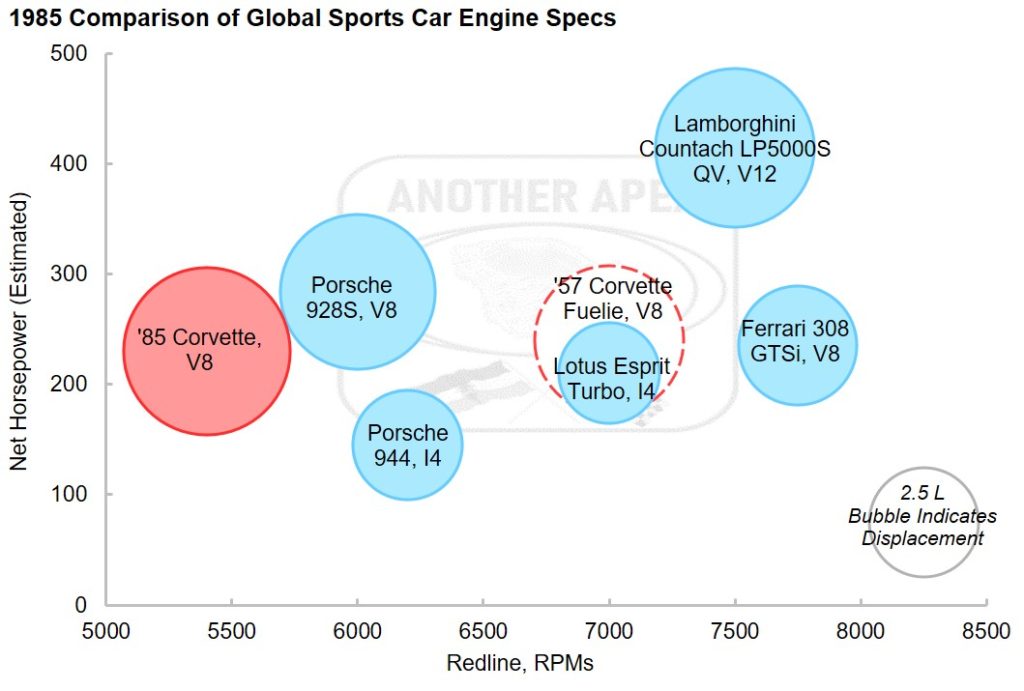
Note: All figures from 1985 except ‘84 Ferrari 308 and ‘57 Corvette Fuelie
Source: The Drive, Hagerty, Jalopnik, Hemmings, Super Chevy, Car & Driver, and Another Apex
Don’t be fooled though. Despite the high RPM ability of the original mechanically actuated fuelie, it still rode Western-Style. Apparently three decades of advances in electronics and computers couldn’t fully make up for the loss – or absence of – compression, short strokes, solid-lifters, and straight pipes, covered in ‘part 5’ of our series.[61] But make no mistake, in 1985 port fuel injection put Corvette back on the page with the leading sports-cars of the world.
Sending a Halo into Orbit
Taken with the original 1985 GM advertisement, it’s obvious that the new electronically fuel injected L98 partially relied on brute force. Perhaps embarrassed by this pedigree, Chevy clearly made an effort to conceal its six-shooter – or more precisely its 5.7 liter – in the Euro comparison add. At the time, Dave McLellan’s team in fact already had a dozen prototypes that force fed the newly fuel injected L98 engine via twin Mitsubishi TDO5 turbos.[62] The resulting 440-570 net horsepower at 6,000 rpm approximately doubled base Corvette horsepower.[62]
At the time McLellan considered Porsche’s 250 horsepower 5.0 liter single overhead camshaft (SOHC) engine a benchmark for normally aspirated 16 valve V8s.[63] Indeed, Anthony Young’s brilliant book, ‘Heart of the Beast’ describes GM Powertrain meetings where the emergence of “multi-valve technology . . . primarily from the Japanese” compelled McLellan, Roy Midgely, and Russ Gee to drop turbo alternatives and start pursuing dual overhead camshafts (DOHCs) in 1984.[64] In Young’s book, Roy Midgely – Chief Engineer of V8 and related V6 engines for Chevy and Pontiac (CPC) – recalled, “Why shouldn’t GM step up into that kind of technology [DOHC] and display the fact that we could do it?”
To Midgely’s point, GM was still the global heavyweight in ’84. So too was it delving into more prescient downsizing projects, like Oldsmobile’s Quad 4 (a DOHC four-cylinder), the NUMMI collaboration with Toyota, and the launch of the import fighting Saturn Division.[65] The problem was that in the mid-80s his boss – Russ Gee, Director of CPC Powertrain – didn’t have any bandwidth left on his engineering team. They were busy working through CPC’s bullpen of 90 degree “V” engines – including Corvette’s – shifting them from wet intake manifolds over to contemporary port fuel-injection; Gee said he “. . . needed to get some design help.[66]”
That’s right, GM’s reluctance to invest in and redeploy port fuel injection technology in the 70s – which would inevitably be needed, based on forthcoming emission and fuel economy requirements – had drastically reduced its ability to react to competitive threats.
Reinforcements from NATO
Soon GM invited Lotus and Porsche consultants to transcend beyond Ed Cole’s utilitarian small-block, and into the echelons of F1 inspired mills and their DOHC technology.[67] The lead candidate to help Chevrolet with its new multi-valve cylinder head project ended up being Lotus, the famed British automotive mark and motorsport veteran. Already involved on other projects for GM, Volvo, Chrysler, and Toyota, Lotus convinced the Americans that designing an entirely new engine block provided the most upside.[68] As the complexity and duration of the DOHC project grew, Chevrolet Marketing’s Don Runkle suggested an aftermarket turbo solution as a bridge over the horsepower hill. Shortly thereafter, McLellan summoned a Connecticut Yankee – Reeves Callaway – to resuscitate the pushrod twin-turbo for GM’s court.[69]
With a surrogate forced induction solution soon available, the more challenging quad camshaft engine had space to gather momentum. Buying into engineer’s “low tech” characterization of pushrod turbos, CPC VP Lloyd Reuss set about to persuade the bean counters – and more importantly GM’s gunslinging Executive Chairman Roger Smith – to develop the clean sheet design Lotus proposed.[70] According to Young, Reuss convinced them “. . . of the marketing aspect of it and how important some of these things [expensive risky niche projects] are” by highlighting how the resulting DOHC know-how might serve as a foundation for higher volume DOHC efforts.[71] As a result, the more practical twin-turbo Corvette continued as an endorsed aftermarket solution, while the elaborate new Lotus engine would be pulled under the GM umbrella for a “King of the Hill” Chevrolet.

The 3.8 liter turbo charged and port fuel injected “SFI” V6 Buick Grand National arrived shortly after the fourth generation Corvette – as a 1984 model-year – with 200 net horsepower. This was approximately equivalent power to Chevy’s “Cross-Fire” injected 5.7 liter V8. . . . A few years later – in 1987 – McLaren and ASC would help Buick release the similar looking inter-cooled 1987 Buick ‘GNX‘ with close to 300 net horsepower. Photo courtesy of Barrett-Jackson Auction Company’
It’s a bit surprising that Reuss was so critical of pushrod turbos. After all, as General Manager of Buick he had been instrumental in launching the revered 1984 Grand National (pictured above), a turbocharged and port fuel injected 3.8 liter V6 with an “underrated 200 horse.[72]” Sure Datsun introduced its Z-car with an overhead cam engine in 1970 and followed with port fuel injection and turbos in 1975 and 1981, respectively.[73] But, presumably, Reuss realized that port fuel injection had only just returned to the small-block in 1985, after a two decade hiatus. If Corvette fans hadn’t deserted wet intake manifolds over the preceding decade [L48, L81, L82, L83], it seems unlikely they’d dismiss a turbo fitted to the new port injected pushrod as “low-tech.”
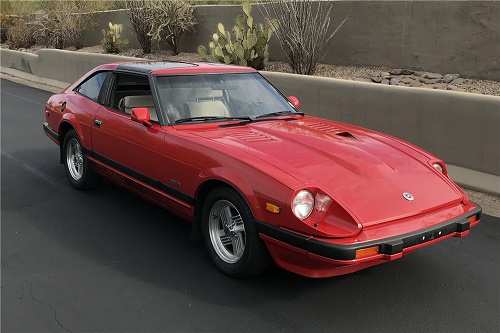
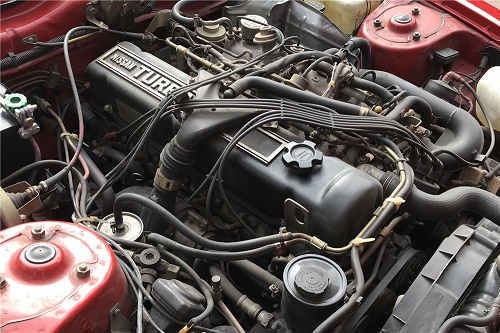
Introduced in 1979, the Datsun 280ZX was Nissan’s second generation “Z” car. Measuring 2.8 liters and offering a turbo option in 1981, the SOHC straight-six had already gained port fuel injection in 1975. This 1983 2+2 turbo cranked out 180 net horsepower and rivaled the ’82 ‘Vette in a sprint. Photo courtesy of Barrett-Jackson Auction Company
And yet Reuss’s ears must have been burning, because in 1986 Toyota released a DOHC Supra and within a year its 3.0 liter inline-six would be turbo-charged to 230 horsepower. Perhaps after leading the engineering development of the fated ’75 DOHC inline-four – for the Cosworth Vega – Reuss felt like the Allies had some unfinished work.[74] But Detroit’s V8 heritage had now put Reuss and team in an awkward situation. Conversion of GM’s legacy multi-bank “V” engines to overhead camshafts required almost twice the complexity of a similar conversion for a single-bank or “I” engine.
Norfolk or New London
By 1987 Callaway Cars in Old Lyme, CT – near the New London Naval Base – had arranged an aftermarket forced induction package for Chevrolet customers thirsty for thrust. Twin turbocharged and intercooled, these “B2K” Corvettes were consummate Yankees, producing gobs of torque (over 500 lbs-ft after the first year) but still redlining at a relatively pedestrian 5400 RPMs.[75]
The chart below rolls the contenders from USAC’s 1985 evaluation forward two years to 1987, also adding the legendary Porsche 911, the Supra, and Callaway’s Turbo Corvette. Rather than revs (RPMs), the chart trends the general escalation of horsepower with each engine’s number of valves. The trend of the normally aspirated engines – blue bubbles – shows the general incremental benefit of valve quantity and – by default – cylinder count. However, the boosted kraut and twin-turbo corn burner – in red – bucked the valve trend by adding turbo(s) to legacy two-valve per cylinder engines.
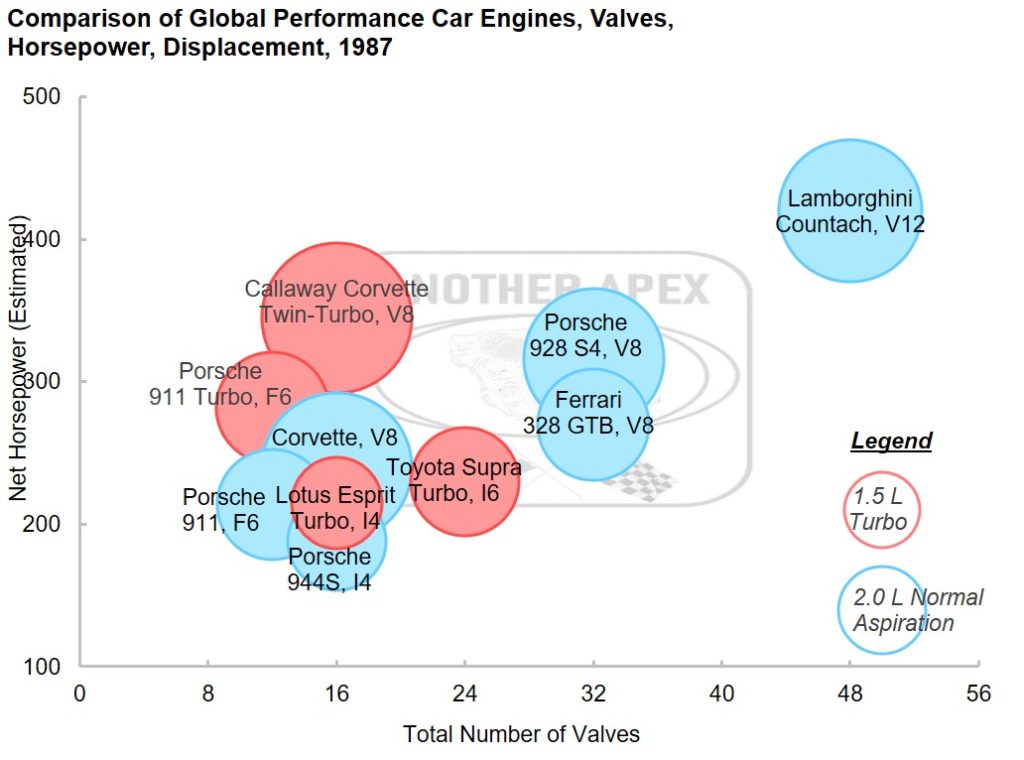
Note: All figures from 1987
Source: Hagerty, Car & Driver, and Another Apex
If You Can’t Beat Them, Buy Them
In 1986, Executive Chairman Roger Smith doubled down on Lotus’s performance solutions. After spending $30 billion between the acquisitions of Ross Perot’s EDS[76] and Hughes Aircraft[77], Smith savored a palletizer by ingesting a 60% interest in Lotus Cars.[78] So starting into their second year on the project, Lotus – GM’s newest subsidiary in Hethel, England – began assembling the first prototype of what they understood might eventually be “. . . the successor to the L98 [Corvette] engine.[79]” And while the project moved forward, GM incrementally bought out the remaining Lotus shareholders.

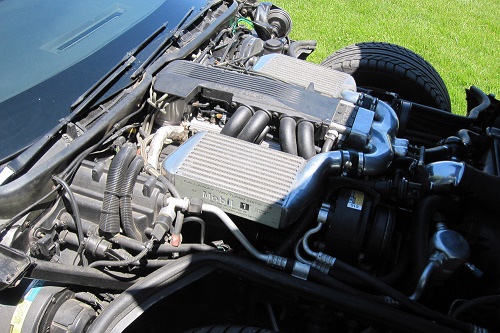
’87 Callaway Corvette; 1987 was the first year option “B2K” could be selected from a few dozen special Chevrolet dealers in the US. Callaway in Old Lyme, CT added two turbos, intercoolers, and other enhancements. Original customers received a factory warranty. Photo courtesy of Barrett-Jackson Auction Company
As the first new V8 Chevy engine block in decades sat for grammar school on a retired Allied Air Force base in England, select US dealers offered Callaway’s twin-turbocharged L98s for a 70-80% premium over base the Corvette’s MSRP. A hundred or so “B2K” optioned Callaways were selling annually when rumors of a GM prince with birthright – sired by the English – began to circulate.
Moonshots
In 1988, the new Lotus/Chevy engine passed its A-level exams, Chevy disclosed the 32 valve Corvette, and MerCruiser began producing the LT5 engine in Oklahoma.[80] Cheers could be heard from Los Angeles to London, after the ZR-1 “arrived” at the 1989 Geneva International Motor Show and finally absolved the Allies of their lingering mechanical insecurities. Indeed, for the 1990 model-year wealthy customers could add either of two $27K engine upgrades to their $32K base Corvettes, the DOHC “ZR1” or the twin-turbo “B2K.”
A more important, but less publicized, coup for GM in 1989, was the poaching of Chevrolet General Manager Jim Perkins from Toyota where – after leaving Buick in ’84 – he had helped launch the Lexus Division.[81] Regrettably, by Christmas the arrival of the new ZR-1 and white hat executive would be juxtaposed by Michael Moore’s release of ‘Roger & Me.’ A satirical documentary movie – the title referencing Chairman “Roger” Smith – that framed the fallout from GM’s depressing grip on Midwest manufacturing.
Nevertheless, with the tabloid power of Prince Harry and Meghan Markle, in the 1990 model-year GM’s regal and “homegrown” 375 horsepower “ZR-1” was 50 times more popular than Callaway’s 385 horsepower Corvette. Parched by two decades of regulation, automotive journalists were soon intoxicated by the stock 7000 RPM redline and 11-inch rear wheels. The ZR-1 quickly became Detroit’s pièces de résistance.
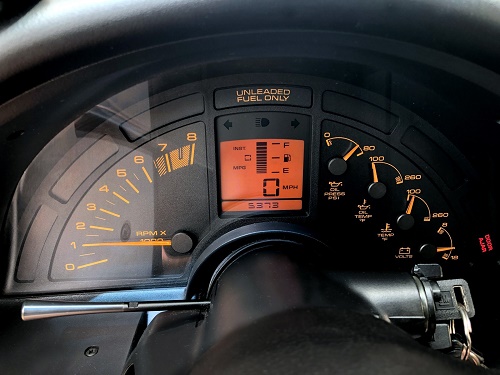
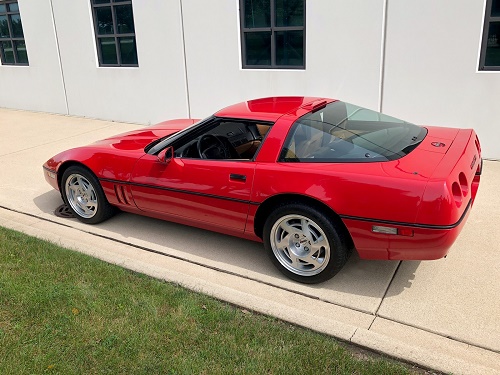

A 1990 Chevrolet Corvette ZR-1 with its LT5 350 cubic DOHC V8 rated at 375 net horsepower. Note the 7000 RPM redline rather than 5200 RPM, like in 1982. 1990 was the only year that its squared ZR-1 tail-lights were exclusive. The rear-end on all C4 ZR-1 vintages – ’90-’95 – added a few inches of extra width. Pictures courtesy of Corvette Mike Midwest, in Burr Ridge, IL.
Indeed, as Chevrolet rolled into 1990, the ZR-1 grabbed the world’s 24 hour speed record, at 174 mph –and– six months later Lloyd Reuss ascended to the GM Presidency. Reuss left his role as VP of Chevrolet Pontiac to fill the spot vacated by Bob Stempel. Stempel – who had resisted Bosch injection for the Corvette in the 70s – had been tapped to replace Roger Smith, who was stuffing a golden parachute.
Basking in the superficial similarity to the zenith of muscle cars from 20 years prior, Chevrolet appeared to have forgotten that the original 1970 ZR-1 ‘shared’ its engine with the plebeian 1970 Z28 Camaro. Propelled with the precision of a Swiss watch, the new ZR-1 usurped its namesake like Schwarzenegger transformed his Terminator role in Terminator 2. Not only had Schwarzenegger’s character switched from ‘bad guy’ to ‘good guy,’ but with ten times the speaking also came ten times the compensation.[82]
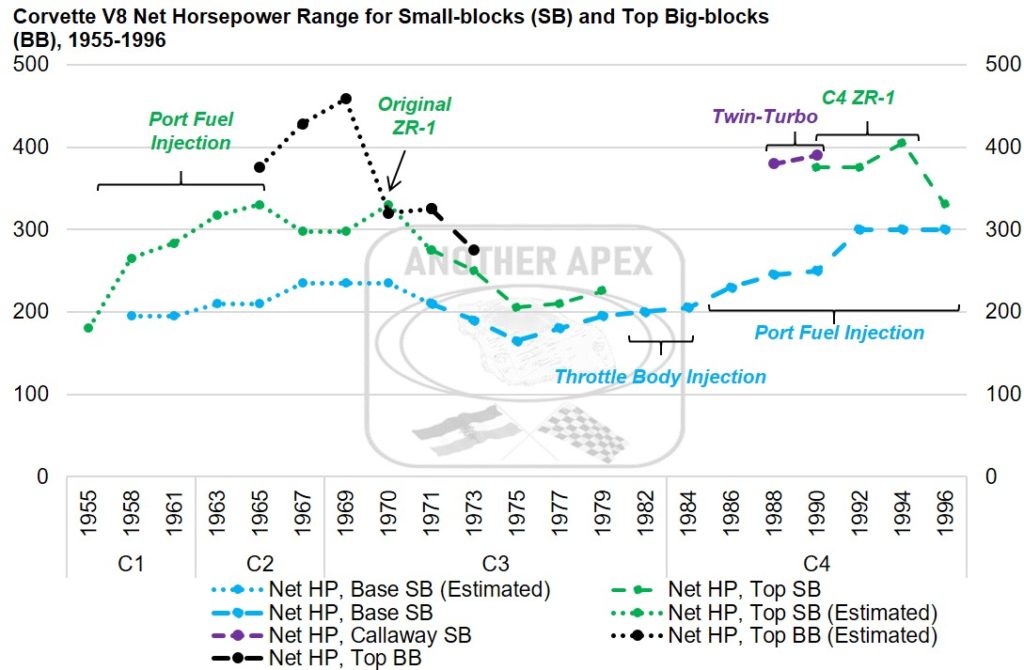
Note: Note: Prior to 1972 model year, reported horsepower was “gross” (i.e. engine dyno-ed without intake or exhaust filtration/obstruction); GM’s published ratings of 425-430 hp were disregarded as conservative for the ’65 L78, the ’67 L88 ,and the ’69 ZL1. Instead gross hp of 442, 560, and 600 respectively was derived from the work of Bob Thomas/Ludvigsen, Hot Rod Magazine Testing, and David Kimble, respectively. Results for the L88 and ZL1 assume intended “day 2” tubular header modifications. Gross horsepower was then converted to net using a ratio between 75 and 85%. Callaway Twin-Turbo horsepower for 1987 [345 hp] and 1991 [403 hp] not shown
Source: Corvette Museum Archives, GM, Noland Adams – Automobile Quarterly, Karl Ludvigsen – Automobile Quarterly, Tom Falconer – Motorbooks, David Kimble – Motorbooks, David McLellan – Bentley, www.hotrod.com/articles/ccrp-0910-chevy-l88-427-engine/ -and- AnotherApex estimates.
The prior chart shows the 50 horsepower advantage that the C4 ZR-1 had over the C3 ZR-1 in green, as well as the slightly more powerful Callaway, in purple. Although still a notch below the power of the aluminum headed big-blocks, [the black line, also covered in parts ‘two’ and ‘three’ of our series] soon the blue blooded ZR-1 was butting heads with Porsche’s 911 Turbo in Car & Driver.[83]
C&D’s article noted that drivers who prioritized “hammer it” responsiveness over exclusivity and fit and finish, might prefer the four-valve per cylinder ZR-1 and its 65 horsepower advantage over the two-valve turbo Porsche. That and, at $64K, the test pointed out that the ZR-1 was $40K easier on American wallets than the force fed German.
Chapter 4: Not in Kansas Anymore (90s)
Wait. . . What?
However after the 1990 model-year was in the books, it turned out NOT to be the ZR-1 that was the harbinger of change. Instead, it was Nissan’s sleek new 300ZX that most captivated customers, enthusiasts, and engineers around the world. With a base price of only $33K, 300 horsepower, four wheel steering, and sculpted futuristic lines, Nissan’s new twin-turbo “Z” represented an incredible value proposition.[84]
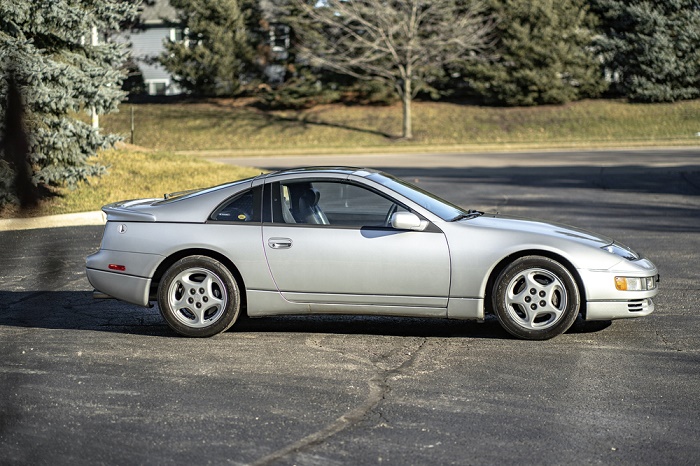

1990 was the year the Nissan 300ZX Twin Turbo and its 300 net horsepower took the L98 Corvette to the matt. Back then Motorweek noted that the 1990 Turbo Z’s “brutal” acceleration humbled its “only real competition” the contemporary Z51 Corvette in the 0-60 and quarter-mile sprints. With seeming clairvoyance Motorweek announced this Z was “ . . . undoubtedly heralding the beginning of a new era of Japanese high performance cars. The Z32 and its twin-turbo DOHC 24 valve 3.0 liter V6 were offered in the US from 1990-1996. Pictured is a 1992 two-seat twin-turbo, but normally aspirated versions were offered in two-seaters or 2+2s. Photo courtesy of Barrett-Jackson Auction Company [Motorweek: https://youtu.be/UINwvXCXbSU accessed 10-24-2019]
Indeed, against a $36K 250 horsepower L98 Corvette Coupe, Car & Driver favored the DOHC V6 Nissan twin-turbo as the “clear” winner. What’s more, C&D’s conclusion lamented the expensive – and therefore not entered – ZR-1 engine upgrade. They said “The Nissan 300ZX Turbo wins a closely fought contest . . . a rematch will have to be postponed until the bow-tie boys can reduce the price of the ZR-1 to, say, the mid-$30,000 range. . .[85]”
Below the 1990 300ZX Turbo and 1990 ZR-1 are added [dotted circles] to the prior list of competitors from 1987 [competitors still use ’87 numbers]. What’s not captured in the comparison is the relative affordability of the $33K Nissan in an 80s fraternity of contenders that sometimes topped $100K MSRP.

Note: All figures from 1987 except ‘90 Corvette ZR-1 and ‘90 Nissan 300ZX
Source: Hagerty, Car & Driver, and Another Apex
Bringing the Halo Back to Earth
The ZR-1 unquestionably boosted GM’s image, but demand tapered off in 1991. Unfortunately just before Smith’s retirement, Iraq invaded Kuwait prompting the hesitation of US consumers.[86] Steeped in a US recession, vehicle demand fell crisply in the 1991 model-year. The next chart shows the sudden loss of sales volumes.
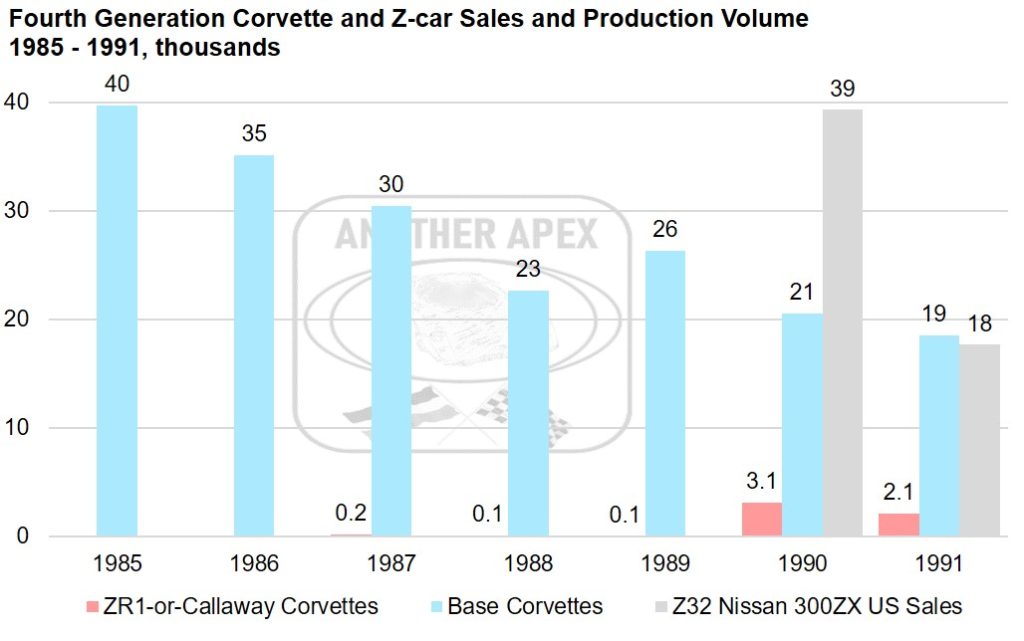
Note: RPO B2K – Callaway’s Twin-Turbo Corvette – was sold from 1987 through 1991 –and- the C4 “ZR-1” option was offered from 1990 through 1995. The “Z32” fourth generation of the Nissan Z includes US sold Turbo, NA, and 2+2 models (i.e. ROW excluded) while Corvette production figures are global..
Source: Corvette Museum Archives, GM, Tom Falconer – Motorbooks, Mike Mueller – Motorbooks, https://zhome.com/History/Zproduction.html accessed 11-30-2019, -and- AnotherApex estimates.
While the ZR-1 tried to catch fading waves, the Callaway Corvette had to bail after 1991 because the L98 engine was to be phased out.[69] Although demand for the Callaway Turbo was four to five times higher than GM’s initial projections, less than a thousand Corvette customers specified the “B2K” option during the five-year run. And even though Lotus had arranged an improved 405 horsepower version of the LT5 for the 1993 model-year, in 1991 GM had reportedly already made the decision to strike the ZR-1 after 1995.[87]
Chevrolet’s decision wasn’t entirely a reflex to poor demand. After Jim Perkins acclimatized to the power struggle that would perforate GM in the 90s, a debate about the need for the pricey ZR-1 flared from inside the company.[88] On reflection Lloyd Reuss told author Anthony Young, “In my opinion, we never had the strong conviction at Chevrolet that the ZR-1 was as important as I felt it was.”
Hindsight can be 20/20. Indeed, after Corvette’s journey to the edge of space, Chevrolet Pontiac Powertrain discovered that Ed Cole’s old small-block was a usable pair of ruby slippers. They just needed some polishing.
The Smith Hit the Fans
As 1993 kicked off – and the apparent hubris of Roger Smith’s GM continued to implode – Chairman Bob Stempel and President Lloyd Reuss had been added to the dossier of casualties. Instead of bringing scale to the new Lotus Elan roadster – introduced in 1989 – GM let go of 300 Hethel employees in 1992, as it cancelled the unprofitable front-driver.[89]
And even with 30 extra horses for the 1993 model-year, the great ZR-1 was already a lame-duck. As assembly trailed to a proscribed 448 cars per year, Bowling Green siphoned from a stockpile of MerCruiser LT5 engines. Unfortunately, Hethel’s planned third boost in LT5 horsepower – from 405 to 475 – would not come to pass.[90] Borrowing words from NASCAR great Cal Naughton Jr., it might be said that GM now figured the intricate 32 valve aluminum LT5 engine went with the Corvette “like Chinese food and chocolate pudding.”

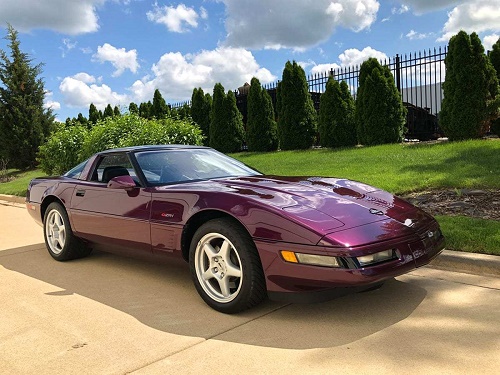
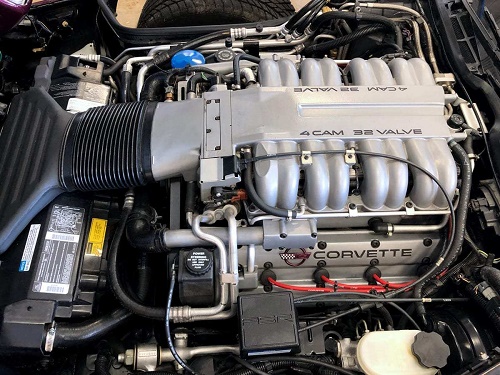
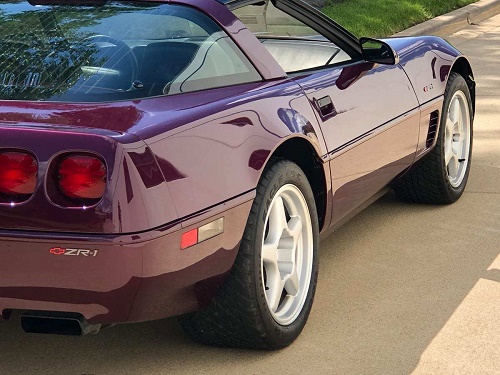
1995 was the last year for the C4 Chevrolet Corvette ZR-1. The Lotus designed aluminum DOHC V8 was built by MerCruiser in Oklahoma. Although its 5.7 liters had been pumping 405 net horsepower since 1993, the 32 valve LT5 missed out on an upgrade to 475 hp due to cancellation. Photos courtesy of Corvette Mike Midwest, in Burr Ridge, IL; car no longer for sale.
No one at GM was immune to the regime shift. In fact, Dave McLellan finished 1992 as a Corvette Consultant, instead of its Chief Engineer. Facing the maelstrom of change, McLellan elected to retire on August 30, 1992, “. . . the last possible day in my early retirement window.” he wrote.[91] But it was the remaining Lotus employees who would really get whiplash.
In August of 1993 – twelve months after McLellan’s retirement – Bugatti agreed to purchase Lotus from GM.[92] For the 200 souls still standing in Hethel, the news was likely greeted with some cynicism and relief. Like contract songwriters, they’d carefully translated their ballads over to an R&B style, only to have their retainers sold to a Baroque Opera Workshop.
'If you don't know where you are going, you might wind up someplace else,' Yogi Berra
Akin to the retaliatory ‘Doolittle Raid‘ in WWII, the ZR-1 program was a victory in propaganda, raising morale with little direct commercial benefit. From 1990 to 1995 about 5% of Corvette buyers upgraded to the LT5 engine, resulting in the production of roughly 7000 C4 ZR-1s.
Ultimately cannibalized by the reemergence of its OHV “LT1” uncle in the summer of 1991, the expensive LT5 – with its sophisticated valvetrain – had become economically obsolete in the GM lineup. A fate coincidentally similar to the “Ram Jet” fuel injection of the 50s and 60s.
Desperate to battle imports with an affordable 300 horsepower – and with CPC Powertrain finally through its backlog of mid-80s port injection adaptations – Powertrain Engineer Anil Kulkarni almost literally turned the L98 upside down. Kulkarni and team managed to economically squeeze 20-30% more horsepower from the iron small-block’s “low-tech” pushrod design.[93]



Ruby Slippers – A 1993 Chevrolet Corvette. Starting in 1992 the base Corvette boasted 300 net horsepower This new 2nd gen “LT1” engine made its herculean nephew – the expensive LT5 which powered the ZR-1 – nearly obsolete. This “Ruby” Anniversary convertible celebrates the 40th year of Corvette and also sports a rare hard-top. Photo courtesy of Barrett-Jackson Auction
Savvy reconfigurations of cooling, fuel-injection, and ignition helped spark second generation normally aspirated pushrod small-blocks with at least 300 horsepower for the ’92-‘96 model-years.[94] More importantly, the team’s effort revealed that their OHV V8 “ruby” slippers – ’93 was Corvette’s 40th anniversary – harbored potential to push well beyond 300 horsepower while using only 16 valves and a single camshaft.[95]
The 7000 LT5 engines that MerCruiser produced in the 90s amounted to about half the quantity of “Ram Jet” fuel injection manifolds that Rochester produced during the 50s and 60s. And although both engine programs were expensive, the 32 valve LT5 – as an entirely new aluminum engine with transatlantic collaboration – was likely dramatically more expensive. Especially considering the ZR-1 project seemed to have ebbed into the acquisition of Lotus.
Nevertheless, both Ram Jet fuel injection and the 32 valve ZR-1 engine likely brought many intangible benefits to Chevrolet, GM, and Detroit, that are impossible to quantify.
There’s No Place Like Home
Ed Cole’s original small-block design typified Chevrolet’s “low priced” philosophy that in McLellan’s words “. . . put complexity into the design process, not into the hardware.[96]” With that in mind, we can’t help but wonder if Corvette, Chevrolet, and GM could have responded more confidently and nimbly to competitive threats in the 80s if they had maintained dedication to technologic development during the 70s.
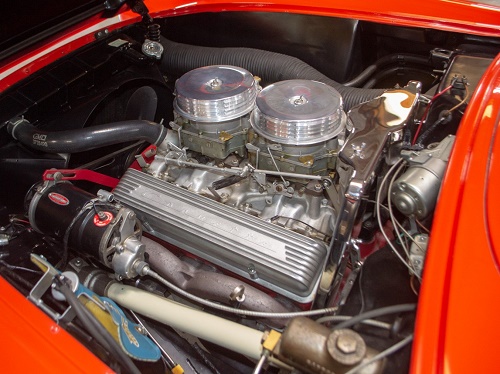
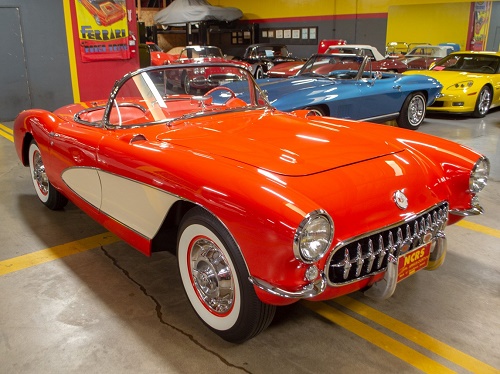
Ed Cole’s original small-block V8 was launched in 1955 and available on any Chevrolet. This high output version with two four barrel carburetors found its way on a 1956 Corvette. It’s 265 cubic inches was rated at 225 gross horsepower and 196 net horsepower. Pictures courtesy of Corvette Mike in Anaheim California
Robert Mittelstaedt Jr. – author of Will your Next Mistake be Fatal – writes, “. . . that nearly all serious accidents, whether physical or business, are the result of more than one mistake. If we do not ‘break the chain’ of mistakes early, the damage that is done, and its cost, will go up exponentially.”
Indeed, it appears to have been port fuel injection’s applicability towards emissions and fuel economy – and the eventual bottleneck in adapting such fuel systems to GM’s portfolio – that forced CPC Powertrain to delay redesign of the 30-year old small-block until the 90s. Even though the project – as initially brought to Lotus – was expected to evolve the small-block while providing desperately needed engineering resources.
In Corvette’s apparent panic to avoid “import” checkmate, the halo apparently believed it had no choice but to develop the revolutionary engine proposed by Lotus Consultants. Consultants that managed to grow the project scope from an inquiry for 300+ horsepower – via new multivalve cylinder heads – to a quixotic reach for 400 horsepower via an entirely new alloy engine, and ultimately the buyout of their whole company.[97] Hopefully as the ZR-1 project wrapped up, GM’s Vauxhall leveraged their new Hethel Consultant’s sales acumen during negotiations with key UK fleet accounts.
EPILOGUE
Wag the Dog
At times as a money-maker and other times as a halo – and since the 90s both – GM tends to wag the Corvette as it would a tail. The wag has been most effective when synchronized with the rhythm of its body of trucks and sedans. For example, the initial design of the pushrod small-block in 1955 – and each subsequent redesign – have typically been opportunities for some good heart-felt tail wagging.[98] Let’s not forget that Chevrolet is the “Heart Beat of America!“
And although we clearly can’t appreciate what a complicated old dog GM was in the 80s – especially with the personality disorders that sometimes grip conglomerates on spending sprees – it seems clear that the DOHC ZR-1 developed into a costly case of the tail wagging the dog.
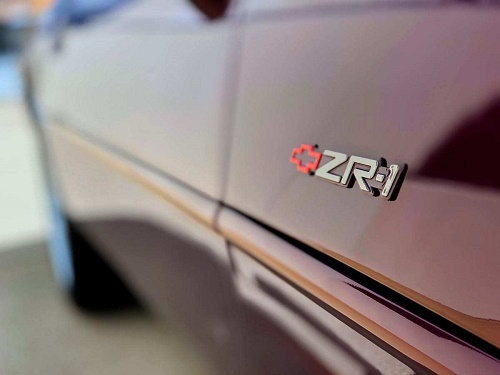

1995 was the last year for the C4 Chevrolet Corvette ZR-1. The Lotus designed aluminum DOHC V8 was built by MerCruiser in Oklahoma. Although its 5.7 liters had been pumping 405 net horsepower since 1993, the 32 valve LT5 missed out on an upgrade to 475 hp due to cancellation. Photos courtesy of Corvette Mike Midwest, in Burr Ridge, IL; car no longer for sale.
Cadillac Northstar
Sure a few years later some elements of the 5.7 liter LT5 engine found their way into Cadillac’s transversely mounted 32 valve Northstar. But in his ZR-1 follow-up book – about the Northstar V8 – author Anthony Young described Cadillac’s desire to conceive a new motor “. . . that would turn the automotive world on its ear.” So not only was Cadillac informed about Hethel’s work on the ZR-1, but to optimize their concept design the Northstar team also disassembled and benchmarked overhead cam engines from Mercedes, BMW, Ferrari, and Lamborghini.[102]
Such comprehensive due diligence helped the 4.6 liter Northstar – a small V8 by American standards – crank almost 300 horsepower when it was released on the ’93 Allanté. Unfortunately, the ZR-1 apparently didn’t share much of its endurance DNA with its celestial second cousin. Indeed, the Cadillac’s Achilles heel seems to have been a flawed head bolt design that frequently led to critical head gasket failures in middle-age.[103]
Global Four Cylinder
On the other hand, a GM stride for an advanced multi-valve – and Lotus designed – powertrain might have turned into a sedan renaissance had it been a so called “global four cylinder.” An economic inline engine sporting a modular design that could see sub-compact to midsize applications, both internationally and domestically. Coincidentally, Hethel’s new front drive Elan needed a transverse DOHC unit in 1992. Apparently, Isuzu’s plans to discontinue their 1.6 liter turbo four – used by the Lotus roadster since its 1989 introduction – had a lot to do with GM’s cancelation of the vehicle.[89]
Hindsight’s perspective reveals that the Corvette ended up reviving the pushrod small-block anyway. So it’s daunting to think what Lotus engineers might have accomplished on GM’s DOHC Cosworth Vega or Quad 4 engines.
In fact, Lotus likely did make some design contributions to the Quad 4, as Oldsmobile launched the project in the early 80s and – even after GM sold Lotus in ’93 – the “fixers” were allegedly brought back to help with GM’s Ecotec four.[99] An engine that’s since appeared in pickups. However, with a more significant allocation of Hethel’s expertise, perhaps the Quad 4 could have had an earlier and “smoother” start. Smoother, because apparently the Quad 4’s lack of refinement – and balance shafts – sucked the “good” right out of vibrations.[100]
Who knows, the Quad 4 might have even found its way into the Fiero, Pontiac’s mid-engined sports car. The wild two-seater that had presciently arrived a few years before Mazda’s Miata stole every Gen Xer’s heart. With a potent aluminum DOHC 2.0 liter, Pontiac might have avoided packing the 2.5 liter Iron Duke in so tightly that Fieros sometimes burst in flames.[101] Certainly, that’s a lot of “ifs” though.
Breaking the Chain
Better than jumping down the 32 valve rabbit hole, Chevy’s desperate need – either perceived or legitimate – for a “high-tech” V8 splash might have been avoided if GM Management had recognized and modernized its core pushrod strengths earlier. At least Buick began rolling out port fuel injection on its venerable 3.8 liter V6 in 1984.
But for Chevrolet in 1984, patient enthusiasts were regrettably asked to “doublethink” that their long awaited fourth generation Corvette, and its Cross-Fire injection, reestablished a modern fuel injected sports car. In reality, an ’84 Toyota Camry had twice as many fuel injectors as the “all new” Corvette that cost three times as much.[104]
More ifs. . .
Even more than usual, in 1965 Detroit suffered from short-term thinking and overconfidence.[105] GM had dropped Dolza and Duntov’s original mechanical port fuel injection like a hot potato and the only engineers that seemed to care about Bendix’s electronic fuel injection lived in Europe. Even the Federal government – at times – had been an accomplice to the glacial arrival of efficient combustion, levying a 10% tax on imports in 1971,[106] and diluting the implementation of 1970’s Clean Air Act by a decade or more.

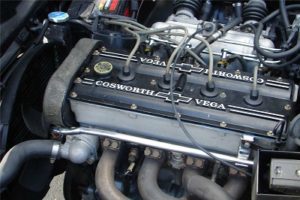
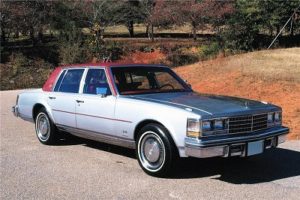
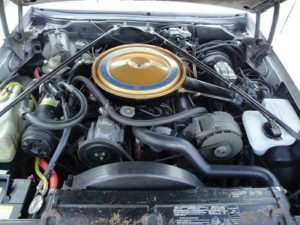
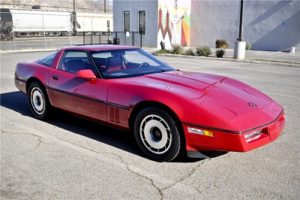
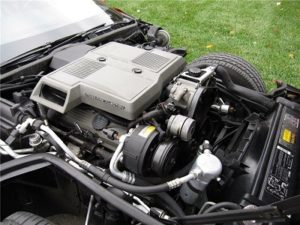
Pic 1 & 2: 1975 Chevrolet Cosworth Vega WITH port fuel injection and a hand-built DOHC 2.0 liter with 16 valves. It had 4 injectors on its I-4.
Pic 3 & 4: 1976 Cadillac Seville WITH Bosch/Bendix port fuel injection. It had 8 injectors on its V8.
Pic 5 & 6: 1984 Chevrolet Corvette WITHOUT port fuel injection. The C4 was introduced with single point injection. It had 2 injectors on its V8.
Photos courtesy of Barrett-Jackson Auction Company
So in the late 70s – with institutional memory already hazy – the Cadillac Seville and Cosworth Vega’s port fuel injection systems failed “General” adoption again. And although Chevy briefly considered adopting a version for the Corvette, few of GM’s marketers realized – or cared – that the old C3 was on “double secret probation.” With continued sales records, in their eyes the regal two-seater had to be more than fine.
Perhaps McLellan could have convinced Chevy Engineering Director Bob Stempel [later GM Chairman ’90-’92] that adoption of port injection was worthwhile in ’77 or ’78 if Duntov had been able to stay on hand as a consultant. But without Ed Cole backstage shining a light on the Corvette, Duntov’s influence would have been uncertain at best.
Coasting Shareholders
Ed Cole’s synchronized retirement with Duntov had meant that the father of the small-block and long-time President of GM – Cole – had been passed over for the top job. Instead, Vice-Chairman Thomas Murphy became Executive Chairman at the end of 1974. Murphy – a past GM Treasurer – seemingly prioritized dividends over development.[107] Indeed, shareholder dividends set new records in 1976 and 1977. As we mentioned in ‘Part 6A,’ when the rockabilly band The Cars released “Good Times Roll” in 1978, GM’s status-quo employees were singing along.[108]
But the pavement was beginning to crack under GM’s cars and Detroit itself. Even a fraction of the $3.6 billion in dividends could have made a huge impact in the auto-manufacturer’s ability to address the mounting competitive and regulatory forces. Indeed adjusting for inflation, the dividends from ’76 and ’77 translate into more than $15 billion today. That’s nearly one-third of GM’s present $50 billion market value.
In fact, front stage at Duntov’s retirement roast in 1975, Cole’s melancholy finale put a “bow tie” on GM in the late 70s. Cole apparently remarked “There’s not a kid on the street who is not interested in new automobiles, new machinery, new ways of doing things . . . The technology’s here, as far as I’m concerned, and we can excite this business. And this is what’s wrong, I believe, with our business today. We don’t have anything really to sell.”[109]
New Management Aimed Straight for Planet Ork
However, it’s a careful balance that must be struck in order to keep investment effective. Especially as industries mature. Indeed, Murphy’s austerity would get whipped into an overcorrection after Executive Chairman Roger Smith took the tiller in 1981. And if Smith’s approval of the ZR-1 project sent the Corvette to the moon, his other strategic initiatives sent the world’s largest automaker on a route to the home planet of Mork [played by Robin Williams], from ‘Mork & Mindy.’
Shortly after GM had metaphorically adjusted its headings for the planet Ork, the newest member of the board – from recently acquired EDS, Ross Perot – publicly aired his frustration with Smith. In fact, the EDS founder and self made Texas billionaire, so detested GM’s culture of feudalism by committee that he was paid $700 million to get off the ship.[110]
In that context, the ZR-1 project was a risk not worthy of criticism and could in fact deserve praise. However, what may be worthy of criticism – in our opinion – was Smith’s taste for numerous seemingly untethered risks in parallel. All while GM’s legacy North American auto assets attempted to thread the needle.[111]
Perhaps if Smith wasn’t burning a Fiero sized hole in his pocket with “transformational” acquisitions and planet sized new divisions, McLellan and Reuss would have stuck with the more conservative approach. There’s no doubt that putting real GM scale behind Dave McLellan and Don Runkle’s turbocharged elixir from Callaway, could have brought ZR-1 levels of performance in earlier and more economically.
Furthermore, such an effort might have brought “King of the Hill” Corvette pricing below that of the successful and attractive – albeit impractical – $52K pushrod Dodge Viper.[112] Indeed, Lamborghini’s aluminum interpretation of Chrysler’s 20 valve pushrod V10 truck engine had set it back $10 million.[113] Certainly the clean sheet LT5 program cost multiples of the Viper V10’s. By comparison, Callaway’s bolt-on twin-turbo solution required very little fixed cost or tooling. As for the turbos and intercoolers, surely a tenfold increase in quantity would’ve tempted IHI, Mitsubishi, and Garrett to bid component pricing lower.
In fact, surprisingly one of the more significant costs in Callaway’s modifications was the rebuilding of the L98 engines with stronger cranks, pistons, connecting rods, and four-bolt main bearing caps.[69] A job that could have been performed during initial engine assembly – at GM Powertrain in Tonawanda or MerCruiser in Stillwater – with any significant volume.
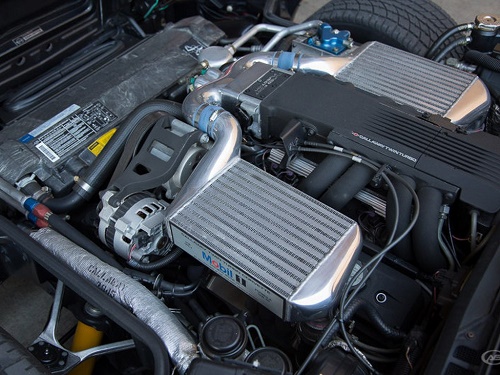
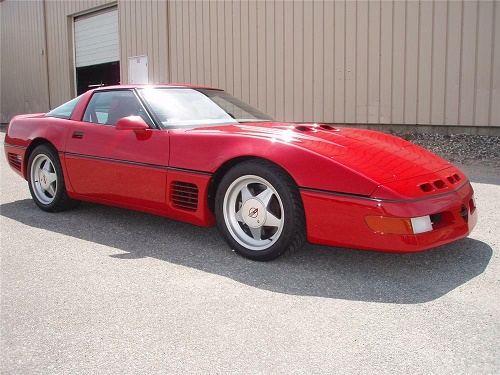
The intercooler and engine bay of a 1990 Chevrolet Callaway Twin Turbo Corvette and the exterior of a 1989 Callaway Corvette with the sleek optional body kit. Pictures courtesy of Barrett-Jackson Auction Company (exterior) and Corvette Mike Anaheim (engine & window)
Budding More Than Engines
However, without Lotus, some discrete and unexpected advances might’ve failed to find their way into later generation Corvettes. For example, McLellan noted that during the ZR-1’s development, Lotus recommended the “torsionally-stiff-backbone” that – since the C5 – has kept Corvette’s torquey rear transaxle on a tight leash.[114] But it certainly isn’t clear whether benefits from the floral escapade with Lotus outweighed their costs. Especially considering that the Hethel subsidiary was believed to have lost about $150 million during its seven years under the General.[115]
Unfortunately, it wasn’t until the arrival of President, and later Chairman, Jack Smith in 1992 [no relation to Roger Smith] that GM again sailed straight.[116] And yet, further into the horizon a US Coastguard “Cutter” would be dispatched to rescue the conglomerate’s rudderless and sinking ship from bankruptcy.
'Deja Vu All Over Again,' Yoggi Bera
A traditional Chevy approach is supposed to put sophistication into design, not process. It’s supposed to be rationale, but simple. So in hindsight, it’s easier to argue that Cole’s original OHV small-block was more “classic Chevrolet” than Bosch/Delco fuel injection, or even Rochester’s mechanical “Ram Jet” injection. But after testing the waters of underperformance with “Cross-Fire Injection” – and exploring over performance with the 32 valve ZR-1 – new generations of port injected pushrod small-blocks reincarnated “classic Chevrolet,” from Caprice to Corvette.


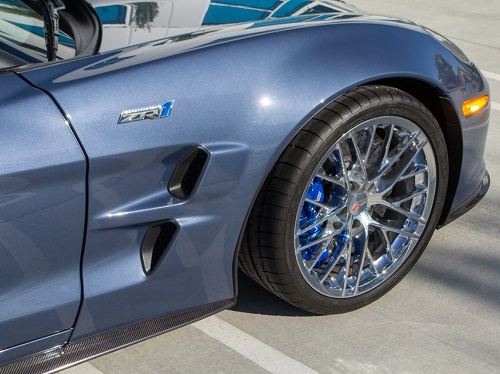
Introduced in 2009, the third generation ZR1 motor – the LS9 – added a 2.3 liter supercharger to the 6.2 liter pushrod aluminum LS block, making its V8 the first factory supercharged Corvette. Its 638 horsepower established a pattern of supercharging, that stuck with “Z” Corvette models through 2019. The photo of this 2011 ZR1 is courtesy of Corvette Mike, Anaheim, CA. https://corvettemike.com/used-corvettes-for-sale/2011-jetstream-blue-corvette-zr-1-coupe/
In fact, Chevrolet seemed to embrace the pushrod V8 as its “Maker’s Mark” during its 21st century renaissance. Subsequent ZR1s – in 2009 and 2019 – somewhat ironically turned out to be forced induction OHV small-blocks, à la the Callaway Twin-Turbo. But with 625 to 750 horsepower and top 10 lap times on elite world tracks, it’s not clear that it matters if some consider the pushrod architecture “low-tech.” On that debate, British automotive journalist Jeremy Clarkson seemed to arrive at a similar conclusion during his “vacation” to Nevada in season 3 episode 8 of Amazon Prime’s The Grand Tour.
Jeremy Clarkson asks his colleagues (Richard Hammond and James May) rhetorically about so called “low-tech” OHV engine architectures:
- “All three of these cars [’19 Jeep Trackhawk, ’19 Cadillac CTSV, ’19 Corvette ZR1] have 6.2 liter supercharged V8s . . [pause for silent affirmation] . .
- . . What I want to know is – right – they are all pushrod engines, , , now whenever I am presented with a pushrod engine I know that I have to go [noises] pff, scoff. . . [Clarkson rolls his eyes, then dejectedly says] Pushrod!? Scoff!
- [Now whispering Clarkson says] But I don’t know why. . . What is a pushrod engine?”
Source: Amazon Prime’s The Grand Tour, Season 3 (i.e. 2019) Episode 8 International Buffoons’ Vacation, 48 minutes from W. Chump & Sons Limited.

The Grand Tour’s James May, Jeremy Clarkson, and Richard Hammond discuss pushrods in front of a Cadillac CTSV, Corvette ZR1, and Jeep Trackhawk. All are left to right.
Source: Amazon Prime and W. Chump & Sons Limited
Rumors suggest that the 32 valve eight-cylinder experiments that rolled out of Duesenberg in the 30s and Corvette in the 90s are slated for a Kentucky Revival. Most likely in one of the mid-engined Corvette C8’s “Z” editions.[117]
If the DOHC V8 resting over the rear axle of the LeMans bound C8R is any guide, Chevy thinks the time is near.[118] Such a decision literally “sounds” intoxicating, especially in ‘flat plane‘ form. But as we imagine the extended vocal range of the Corvettes at ‘Daytona‘ next month, we can’t help but appreciate the key role that the pushrod small-block continues to play in Chevrolet’s success.
Please stay tuned for the affordable and authoritative crescendo of horsepower in future episodes.
Written by Jez Stephens
Further Explanation and Reading
For further explanation, entertainment, and confusion on the overhead cam vs. pushrod debate, please head to ‘prime video‘ and watch season 3 episode 8 of “The Grand Tour.” It’s a phenomenal series and we can’t wait till next season! On the other hand, if you are interested in learning more about various types or fuel injection – or you want to learn about pushrods without being confused – please see Jason Fenske’s ‘valve explanation’ and ‘injector explanation’ for more details.
This is a good time to remind readers that cylinder valves – that allow air/fuel mixture (and exhaust matter) to enter (and escape) the combustion chamber – are separate and distinct components from fuel injectors. Typically a single fuel injector is assigned to each cylinder in pushrod (OHV), single overhead cam (SOHC), or dual overhead cam applications (DOHC). In other words, typical V8 applications have eight injectors regardless of whether they have 16 valves [OHV or SOHC – 8 intake and 8 exhaust] or 32 valves [DOHC – 16 intake and 16 exhaust]. The DOHC C4 ZR-1 – and OHV C7 ZR-1 – are exceptions, since both generations of the LT5 V8 have 16 injectors, two per cylinder.
Finally, our research benefited from the insight of a number of excellent authors, journalists, and engineers. Our citations below detail these works. However, for this edition of “Corvette Power C1 – C8,” the books written by Jerry Burton (Zora Arkus-Duntov), Paul Ingrassia & Joseph White (The Fall & Rise of the American Automobile Industry), David McLellan (Corvette from the Inside),and Anthony Young (Camaro, Heart of the Beast, The Northstar V8) have been especially helpful and deserve a spot on the shelves of any Chevrolet enthusiasts.
Citations and Notes
[1] “Collectors Originality Guide, Corvette Stingray,” Tom Falconer, 2008 MBI Publishing Company, page 85
[2] 330 net horsepower L84 and LT-1 figures from Original Corvette; the Restorer’s Guide 1968-1982, by Tom Falconer, MBI publishing company, 2001, page 52 -and- Dave McClellan, Corvette from the Inside, Bentley, 2002 page 183
[3] “Original Corvette, The Restorer’s Guide 1968-1982” Tom Falconer, 2001 MBI Publishing Company, page 91
[4] Joseph Kraft – The Downsizing Decision, The New Yorker, 4-27-1980 https://www.newyorker.com/magazine/1980/05/05/the-downsizing-decision accessed 11-26-2019
[5] Laurel Graefe – https://www.federalreservehistory.org/essays/oil_shock_of_1978_79 accessed 11-1-2019
[6] Benjamin Hunting – https://www.automobilemag.com/news/gm-x-cars-chevrolet-citation-oldsmobile-buick-pontiac-photos-history/ accessed 11-1-2019
[7] Danillo Almeida – https://medium.com/cardesignchronicles/ford-escort-in-the-1980s-a-tale-of-three-sedans-4f7d6f13be3c accessed 11-1-2019
[8] https://www.npr.org/templates/story/story.php?storyId=96922222 accessed 11-1-2019
[9] Jerry Burton’s book “Zora Arkus-Duntov” Bentley Publishers, 2002, page 372
[10] Small Block Chevy Performance, Dave Emanuel, Berkley Publishing Group 1996, page 33
[11] Jerry Burton’s book “Zora Arkus-Duntov” Bentley Publishers, 2002, page 163
[12] Diana Kurylko https://www.autonews.com/article/20111031/CHEVY100/310319922/the-vega-an-unmitigated-disaster accessed 11-1-2019
[13] Randy Bolig https://www.chevyhardcore.com/features/car-features/cosworth-vega-0219/ accessed 10/9/2019
[14] Harry Stoffer – https://www.autonews.com/article/20080914/ANA03/809150303/lordstown-man-vs-machine-and-gm-was-the-big-loser accessed 11-14-2019
[15] Matt Blitz – https://www.popularmechanics.com/cars/a28749/the-future-past-delorean/ accessed 11-1-2019
[16] Jeff Koch, Hemmings Motor News, March 2016 “Electronic fuel injection also allowed the Seville to run clean enough to pass 1976 California emissions standards without the use of a catalytic converter; it used one, but strictly speaking it didn’t require it. More than power or economy, easily passing the emissions-sniffer test helped popularize fuel injection in the 1980s.” https://www.hemmings.com/blog/article/standards-of-the-whirled-rolls-royce-silver-shadow-cadillac-seville/ accessed 9/30/2019
[17] Jeff Koch https://www.hemmings.com/blog/article/scaled-down-luxury-1976-cadillac-seville/ accessed 9/26/2019
[18] Corvette’s Second Chief Engineer – Dave McLellan – noted in his book that the Cadillac’s necessity to work with Bosch on port fuel injection caused GM Management to drag their heals on further collaboration with the German injector experts until well into C4 production. Eventually GM’s Delco did with Bosch to incorporate fuel injection into the 1985 L98 Corvette though. McLellan specifically implies that Chevrolet’s Rochester port fuel injection – co-designed by Zora Duntov himself in the 50s – had been abandoned too long ago to of use in the 80s. In other words, both modernizing the Rochester mechanical port injection system – which had benefitted from Duntov’s personal connections with Mercedes – and starting fresh with Bosch, were considered too expensive in 1979. Dave McClellan, Corvette from the Inside , Bentley, 2002 page 102 and 134
[19] http://www.superchevy.com/features/vemp-0411-1980-duntov-chevy-corvette accessed 9/27/2019
[20] Dave McClellan, Corvette from the Inside, Bentley, 2002 page 79
[21] In 1987 all Corvettes and their L98 engines had aluminum heads https://www.gmheritagecenter.com/docs/gm-heritage-archive/historical-brochures/Corvette-Historical-Brochures/Corvette-Historical-Brochure-1987.pdf accessed 2-1-2019
[22] The Cadillac Northstar V-8: A History, Anthony Young, McFarland & Company, 2017, pages 32-33
[23] Corvette, America’s Star-Spangled Sports Car, Karl Ludvigsen, Automobile Quarterly, 1977, page 58
[24] The General Motors Fuel Injection System, John Dolza, E. A. Kehoe, Donald Stoltman and Zora Arkus-Duntov, SAE Transactions. Vol. 65, pp. 739-757 SAE International 1957
[25] https://www.topspeed.com/cars/mercedes/1957-mercedes-300sl-roadster-ar14961.html accessed 2-3-2019 -and- Noland Adams, The Complete Corvette Restoration & Technical Guide Vol 1 1953-1962, 1980 Princeton Publishing p204 and Mike Mueller’s, The Complete Book of Corvette, 2014 Motorbooks, p285
[26] A Cadillac powered Allard J2 finished third in the 1950 LeMans https://www.hemmings.com/blog/article/1949-1954-allard-j2-and-j2x/ accessed 10-10-2019 and
[27] 20% more horsepower per liter and 30% more horsepower per pound: 1957 Chevrolet Bel Air Sports Coupe with solid lifter and fuel injection: $2813, 283 ghp, 4.6 liter V8, 3283 lbs ; 1957 Cadillac Series 62 Coupe $4677, 300 ghp, 6.0 liter V8, 4565 lbs. per American Cars, 1946-1959, J. Flory Jr., McFarland, 2004, pp 785-793
[28] At $5782 the ’57 Bonneville cost more than the series 62 Cadillac. Nick D – https://www.supercars.net/blog/1957-pontiac-bonneville-convertible/ accessed 11-15-2019
[29] https://rmsothebys.com/en/auctions/sj16/motor-city/lots/r154-1957-chevrolet-bel-air-fuel-injected-convertible/363525 accessed 10/15/2019
[30] http://chevroletfuelinjection.com/pontiac-fuel-injection-1957-1958/ accessed 11/13/2019
[31] Chris Shelton http://www.superchevy.com/features/1707-1960-corvette-thats-part-of-a-very-famous-le-mans-winning-race-team accessed 10/14/2019 -and- https://www.corvetteracing.com/news/sebring-to-celebrate-corvettes-racing-heritage-in-hall-of-fame-ceremony/
[32] David Weitzman, Model T – How Henry Ford Built a Legend, Crown Publishing New York, 2002
[33] David Crolla, Automotive Engineering: Powertrain, Chassis System and Vehicle Body, Butterworth-Heinemann, 2009 page 628
[34] David Weitzman, Model T – How Henry Ford Built a Legend, Crown Publishing New York, 2002
[35] 13,289 total Chevy Production ’57-’65 http://chevroletfuelinjection.com/fun-f-i-facts/ accessed 11-15-2019. Total Chevrolet car penetration – [sedans, coupes, and roadsters] based off annual reports 1,519,340 passenger car production and approximates based off known Rochester Fuel Injection serial numbers from Noland Adams, The Complete Corvette Restoration & Technical Guide Vol 1 1953-1962, 1980 Princeton Publishing, page 197
[36] Jay Leno and Mike McCluskey discuss Jay’s ’63 Corvette https://youtu.be/_lJXLalMKSA accessed 10/14/2019
[37] Thom Taylor https://www.hotrod.com/articles/you-can-buy-the-holy-grail-of-mopar-engine-options-on-craigslist/ accessed 10/15/2019 –and– The Advent Of Fuel Injection, Newsletter of the Mile-High Section, Mercedes-Benz Club of America, March, 2016 https://autouniversum.wordpress.com/2010/09/25/the-advent-of-fuel-injection/ accessed 10/15/2019
[38] Dietrich Kuhlgatz https://www.bosch.com/stories/50-years-of-bosch-gasoline-injection-jetronic/ accessed 10/15/2019
[39] https://www.volkswagenag.com/presence/konzern/documents/history/englisch/Heft9_EN.pdf accessed 11/15/2019 page 109
[40] Corvette, America’s Star-Spangled Sports Car, Karl Ludvigsen, Automobile Quarterly, 1977, page 56
[41] – Julie Armstrong https://www.autonews.com/article/20040823/SUB/408230807/electronic-fuel-injection-a-history-lesson accessed 10/15/2019 -and- Mark McCourt https://www.hemmings.com/blog/article/1962-1973-volkswagen-type-3-1500-1600/ accessed 10/15/2019
[42] Jane Seaberry https://www.washingtonpost.com/archive/business/1979/08/26/gasohol/2112a522-da3d-493d-919a-0e9f9c1a50fe/ accessed 10/15/2019
[43] Computerized Engine Controls, Steve V. Hatch, Delmar Cengage Learning. 2008, page 258
[44] Computerized Engine Controls, Steve V. Hatch, Delmar Cengage Learning. 2008, page 237
[45] Modernizing the Rochester mechanical port injection system – which had benefitted from Duntov’s personal connections with Mercedes – and starting fresh with Bosch were considered too expensive in 1979 according to Dave McLellan. He notes in his book that Cadillac’s necessity to work with Bendix/Bosch on port fuel injection caused Chevrolet Engineering Director Bob Stempel to drag his heals on further Bosch/Bendix collaboration. Eventually GM’s Delco did incorporate port fuel injection into the 1985 L98 Corvette with Bosch. McLellan also specifically implies that Chevrolet’s Rochester port fuel injection – co-designed by Zora Duntov himself in the 50s – had been abandoned too long ago to of use in the 80s. The 50 Year Development History, Dave McLellan, Bentley 2002, page 101 and 102
[46] https://www.corvettepacifica.com/products/17830/tachometer-assembly-with-5200-rpm-red-line-305-80/ accessed 11/21/2019
[47] https://www.gmheritagecenter.com/docs/gm-heritage-archive/historical-brochures/Corvette-Historical-Brochures/Corvette-Historical-Brochure-1982.pdf accessed 1/27/2019
[48] US National Highway Traffic Safety Administration (NHTSA) http://classic-car-history.com/85-mph-speedo.htm accessed 2-18-2019
[49] “[C5 design] I remember the day I came back from Design and they had an 8000 RPM tach . . . that meant a good portion of the tach was just red – unusable – and they just liked the idea of an 8000 RPM tach. I hated it because it made the resolution of the working part of the tach smaller. And I expressed that . . . [to Design and Chief Engineer Dave Hill and won]” https://www.youtube.com/watch?v=bbqKW3hDhmQ accessed 2-14-2019
[50] Undoubtedly, Chevrolet’s “fit and finish” comments were intended to celebrate the “Newest Sports-Car Production Facility in the World” Corvette’s Bowling Green, Kentucky assembly plant; St. Louis Corvette production ended during the 1981 model-year. The new coke controversy was recently revisited by Adam Campbell-Schmitt – https://www.foodandwine.com/news/new-coke-vs-coca-cola-taste-test accessed 11-16-2019
[51] Inside GM, VP Alex Mair impassionedly recognized that quality needed to improve as his top-secret “Mona Lisa room” forensically dismantled Japanese vehicles. Mair’s August, 1981 “Time has run out” presentation to GM’s executive committee about Japan’s edge in cost and quality served as a catalyst for the Vehicle Assessment Center. Comeback, The Fall & Rise of the American Automobile Industry, Paul Ingrassia and Joseph White, Simon & Schuster, 1994 pages 89 & 90
[52] Kurt Ernst – https://www.hemmings.com/blog/2019/02/05/a-mid-engine-corvette-with-rotary-power-the-1973-xp-897-gt-concept/ – accessed 11-22-2019 –and– Chuck Nerpel – https://www.motortrend.com/news/1978-mazda-rx7/ – accessed 11-22-2019
[53] McLellan goes onto explain that the single-plane manifold’s short design for 1982’s cross-fire system was required on the L83 so that it could fit under the bonnet of the next generation 1984 Corvette. Generally, efficient wet-manifolds grew tall “in an attempt to minimize the air-fuel ratio variations
[54] Corvette from the Inside: The 50 Year Development History, Dave McLellan, Bentley 2002, page 80
[55] The Complete Book of Corvette, Every Model Since 1953, Mike Mueller, 2006, page 211
[56] In 1987 all Corvettes and their L98 engines had aluminum heads https://www.gmheritagecenter.com/docs/gm-heritage-archive/historical-brochures/Corvette-Historical-Brochures/Corvette-Historical-Brochure-1987.pdf accessed 2-1-2019
[57] Noland Adams, The Complete Corvette Restoration & Technical Guide Vol 1 1953-1962, 1980 Princeton Publishing
[58] Corvette from the Inside: The 50 Year Development History, Dave McLellan, Bentley 2002, page 135
[59] Photography Magazine Advertisement, July 1985, page 41 and http://www.thedrive.com/drive-nbc-sports/15159/this-is-what-its-like-to-drive-a-1985-lamborghini-countach-lp5000s-qv accessed 2/4/2019
[60] Photography Magazine Advertisement, July 1985, page 41 and http://www.thedrive.com/drive-nbc-sports/15159/this-is-what-its-like-to-drive-a-1985-lamborghini-countach-lp5000s-qv accessed 2/4/2019
[61] The ’57 283 [and the ’67 Z28’s 302] used a short higher revving 3 inch stroke, vs. 3.5 inch stroke for the 350. David Reher of Reher-Morrison Racing Engines describes the difference in performance made by stroke “Today the race-inspired big-bore/short-stroke 302 is lionized by enthusiasts as one of Chevy’s finest first-generation small-blocks, while the small-bore/long-stroke 305 symbolizes the dreary performance of the smog-motor era. Even though the two engines had nearly identical displacements, their performance characteristics were decidedly different.” https://rehermorrison.com/tech-talk-66-go-big-or-go-home/ accessed 10/29/2019
[62] Hib Halverson – https://www.corvette-mag.com/issues/125/articles/the-c4-gets-serious accessed 10-29-2019
[63] Corvette from the Inside: The 50 Year Development History, Dave McLellan, Bentley 2002, page 100 and 195
[64] Heart of the Beast, Anthony Young, Automobile Quarterly, 2005, page 20
[65]David Tracy- https://jalopnik.com/heres-why-the-quad-4-was-one-of-gms-most-important-engi-1829719965 accessed 11/9/2019 -and- Anne B. Fisher – https://money.cnn.com/magazines/fortune/fortune_archive/1985/11/11/66593/index.htm accessed 11-25-2019
[66] The Cadillac Northstar V-8: A History, Anthony Young, McFarland & Company, 2017, pages 32-33
[67] Brandan Gillogly – https://www.hagerty.com/articles-videos/articles/2019/08/08/c4-zr1-corvette-chief-engineer-mclellan accessed 8-12-2019. Anthony Young notes in his books that Russ Gee also sought consultations at Ilmor, Cosworth, and others in 1984.
[68] Heart of the Beast, Anthony Young, Automobile Quarterly, 2005, page 23 –and- The Cadillac Northstar V-8: A History, Anthony Young, McFarland & Company, 2017, pages 62
[69] Conversation with Reeves Callaway 12-13-2019 allowed refinements from an earlier version -and- Dave McClellan, Corvette from the Inside, Bentley, 2002 page 206 -and- Hib Halverson – https://www.corvette-mag.com/issues/125/articles/the-c4-gets-serious accessed 10-29-2019
[70] Hib Halverson – https://www.corvette-mag.com/issues/125/articles/the-c4-gets-serious accessed 10-29-2019
[71] The Cadillac Northstar V-8: A History, Anthony Young, McFarland & Company, 2017, pages 34
[72] Rick Jensen – http://www.superchevy.com/features/1407-30-years-of-three-gm-efi-legends accessed 10-29-2019
[73] Z-Car, A Legend In Its Own Time, Ben Millspaugh, TAB Books, 1991 page 21 and 30
[74] Randy Bolig – https://www.chevyhardcore.com/features/car-features/cosworth-vega-0219/ accessed 10/9/2019 –and– Aaron Severson – https://ateupwithmotor.com/model-histories/buick-regal-grand-national-gnx/ accessed 10-29-2019
[75] https://www.roadandtrack.com/new-cars/reviews/a9819/callaway-twin-turbo-corvette/ accessed 2/4/2019 https://www.youtube.com/watch?v=ihU-x3WXjZg 4:21 accessed on 2-4-2019
[76] https://www.washingtonpost.com/archive/politics/1984/06/29/gm-perot-computer-firm-agree-on-25-billion-merger/88790acf-6b14-4504-af8f-6c874ed27e97/?noredirect=on&utm_term=.f77375f297cf accessed 2-5-2019
[77] https://www.nytimes.com/1985/06/06/us/gm-to-acquire-hughes-aircraft-in-5-billion-bid.html accessed 2-5-2019
[78] http://archive.fortune.com/magazines/fortune/fortune_archive/1986/02/17/67169/index.htm accessed 2-4-2019
[79] Heart of the Beast, Anthony Young, Automobile Quarterly, 2005, page 22
[80] https://www.mercurymarine.com/en/us/legacy/history/week12 accessed 11-1-2019
[81] https://www.corvettemuseum.org/learn/about-corvette/corvette-hall-of-fame/jim-perkins/ accessed 12-2-2019
[82] Andrea King – https://ew.com/article/1991/07/19/arnold-schwarzeneggers-words/ accessed 12-3-2019 -and- https://ew.com/article/1991/07/12/arnolds-schwarzeneggers-few-words/ accessed 12-3-2019
[83] Rich Ceppos – https://www.caranddriver.com/reviews/comparison-test/a15141368/1991-chevrolet-corvette-zr-1-vs-1991-porsche-911-turbo-submodel-comparison-test/ accessed 2-4-2019
[84] Kevin Wilson, Autoweek October 9, 1989, https://autoweek.com/article/car-life/25-years-later-nissan-300zx-twin-turbo-still-worthy-dreaming accessed 11-5-2019
[85] John Phillips https://www.caranddriver.com/reviews/comparison-test/a15112003/1991-chevrolet-corvette-z51-fx3-vs-nissan-300zx-archived-comparison-test/ accessed 11-5-2019
[86] Carl E. Walsh, What Caused the 1990-1991 Recession? Economic Review, Federal Reserve Bank of San Francisco, 1993 Number 2
[87] Barry Kluczyk – http://www.superchevy.com/how-to/engines-drivetrain/1806-the-original-lt5-and-what-could-have-been accessed 11-5-2019
[88] According to Anthony Young’s book “Heart of the Beast,” Matt DeLorenzo wrote a series of Autoweek articles in 1991 that suggested the ZR-1 was “under review.” Automobile Quarterly, 2005, page 128
[89] https://www.autoexpress.co.uk/lotus/104980/lotus-elan-m100-buying-guide-and-review-1989-1996 accessed 12-2-2019 -and- The Economist , Lotus-Eater, 20-6-1992, page 66
[90] Barry Kluczyk – http://www.superchevy.com/how-to/engines-drivetrain/1806-the-original-lt5-and-what-could-have-been accessed 11-5-2019
[91] Dave McClellan, Corvette from the Inside, Bentley, 2002 page 252
[92] Bloomberg News – https://www.nytimes.com/1993/08/28/business/company-news-gm-sells-its-lotus-group-to-bugatti.html accessed 12-3-2019
[93] https://www.sae.org/publications/technical-papers/content/920673/ accessed 11/7/2019
[94] Corvette Racing, by David Kimble, Motorbooks 2012, page 79
[95] Camaro, Anthony Young, MBI Publishing 2000, page 125
[96] Dave McClellan, Corvette from the Inside, Bentley, 2002 page 36
[97] Heart of the Beast, Anthony Young, Automobile Quarterly, 2005, page 20-25
[98] https://media.gm.com/autoshows/small_block/2011/public/us/en/powertrain/news.detail.html/content/Pages/news/us/en/2011/Nov/100M/1129_100M_Cole.html accessed 11-16-2019
[99] Jeff Chan – http://www.sandsmuseum.com/cars/elise/experience/comments/enginebyjeff.html accessed 12-4-2019
[100] David Tracy- https://jalopnik.com/heres-why-the-quad-4-was-one-of-gms-most-important-engi-1829719965 accessed 11/9/2019
[101] The only way for engineers to fit the bulky 2.5 liter four cylinder into the Fiero was to reduce its oil pan capacity one quart, in conjunction with 10-40% of defective early connecting rods, and a significant number of inversely wired cooling fans, Fieros were prone to run hot, fracture, and burn Comeback, The Fall & Rise of the American Automobile Industry, Paul Ingrassia and Joseph White, Simon & Schuster, 1994 pages 102 – 106, also Jack Walsworth – https://www.autonews.com/article/20160301/CCHISTORY/160229863/pontiac-drops-the-fire-plagued-fiero accessed 11-14-2019
[102] The Cadillac Northstar V-8: A History, Anthony Young, McFarland & Company, 2017, pages 60-62
[103] “Really, really the problem on these [some Northstar engines] is the threads were like really shallow fine threads and the diameter of the bolt was very small. A steel bolt into aluminum – when you try to put those kinds of pressures with just little fine threads – . . . it actually pulls a complete set of threads out of the block. That’s not very conducive to holding a cylinder head down.” –and– “It wasn’t until 2005 that they finally got it fixed. After that year they really don’t have this problem anymore. They went to LS6 head bolts [C5 Corvette Z06] and that took care of the problem.” Quotes from The CAR WIZARD 3-20-2019 https://youtu.be/-nf0bp4dmZU accessed 11-22-2019 –and– http://www.northstarperformance.com/hgfaq.php accessed 11-16-2019
[104] Frank Markus – https://www.motortrend.com/news/1983-toyota-camry-feature-flashback/ accessed 11/14/2018
[105] Del Schroeder, Look Out America! Our Auto Industry is Living on Borrowed Time, lookoutamerica.org, 2011, page 15
[106] Patrick Wright, On a Clear Day You Can See General Motors, Wright Enterprises, 1979, page 167
[107] https://www.automotivehalloffame.org/honoree/thomas-a-murphy/ accessed 11/18/2019
[108] Jon Dolan, Patrick Doyle, Brian Hiatt, Christian Hoard, Elias Leight, Rob Sheffield, and Hank Shteamer – https://www.rollingstone.com/music/music-features/cars-ric-ocasek-essential-songs-884841/ accessed 11-18-2019
[109] Jerry Burton’s book “Zora Arkus-Duntov” Bentley Publishers, 2002, page 359
[110] Ross Perot had been the largest shareholder in GM after the acquisition of EDS; in 1986 Perot surrendered his shares for the $700 million payment. Comeback, The Fall & Rise of the American Automobile Industry, Paul Ingrassia and Joseph White, Simon & Schuster, 1994 pages 118 – 120
[111] Jeff Bezos aside, in our opinion generally focused strategic initiatives near a core competency see the most success. Especially, when legacy businesses are not performing. Executive Chairman Roger Smith launched many uniquely promising projects, but on his watch GM cast such a wide net that critical feedback was sometimes ignored, especially with respect to derelict manufacturing practices. During the 80s, GM bought the IT firm Electronic Data Systems, bought Hughes Aircraft, built an entirely new division (Saturn), collaborated with Toyota in NUMMI, purchased 50% of SAAB, purchased Lotus, invested heavily in robots, shut many legacy plants, laid off thousands of workers, promised electric vehicles, and launched many other significant projects. Success in each effort isn’t the responsibility of a single person – especially in a firm as large as GM – but the result of the collective outcome falls to senior management, especially the board’s executive directors.
[112] Joe Tralongo – https://www.autotrader.com/car-shopping/look-back-dodge-viper-255562 accessed 11-19-2019
[113] Bob Lutz – https://www.roadandtrack.com/car-culture/a28370279/chrysler-wanted-a-lamborghini-badged-k-car/ accessed 11-25-2019
[114] Randy Leffingwell, Corvette Sixty Years, MBI Publishing 2012, page 161 -and- Dave McClellan, Corvette from the Inside, Bentley, 2002 page 239
[115] Richard Feast – https://www.independent.co.uk/news/business/management-poised-for-buyout-at-group-lotus-sale-would-end-seven-costly-years-of-ownership-for-1455046.html accessed 11-19-2019 -and- David Bowen – https://www.independent.co.uk/news/business/bugatti-buys-lotus-from-general-motors-car-makers-to-continue-as-separate-operations-but-share-1463783.html accessed 11-19-2019
[116] https://www.automotivehalloffame.org/honoree/john-f-jack-smith-jr/ accessed 11-19-2019
[117] “Z” designates Corvette RPO codes that include engine enhancements such as “Z06” and/or “ZR1,” not the “Z51” as it tends to be more of a handling package, Dusenberg’s massive straight eight had DOHC and even a supercharger before the depression https://www.hemmings.com/blog/article/1931-duesenberg-model-j/ accessed 11-18-2019
[118]Bob Sorokanich https://www.roadandtrack.com/motorsports/a29429448/corvette-c8r-gets-a-flat-crank-55-liter-v-8-with-dual-overhead-cams/ accessed 11-19-2019



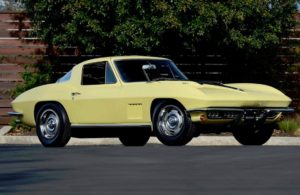


Good article. There is some misinformation regarding the Callaway B2ks but all in all good stuff. Horsepower number, build complexity etc.
Thank you for your comment JC!
We intended a bit of hyperbole in the sentence “By comparison, Callaway’s bolt-on twin-turbo solution required very little fixed cost or tooling.” Nevertheless, it may be appropriate to add more detail on the transformation the L98 went through at Callaway. Thanks for your suggestion.
As far as horsepower, if you are referring to the bubble charts in chapter 3 & 4, please consider that both charts show the 1987 B2K. The only vehicles updated to 1990 – in the second chart – are the ZR1 and the 300ZX. We can make that more clear. In fact, time permitting we may update all the car’s statistics to 1990 for the second chart. As far as the line chart in chapter 3, we’ll confirm figures again but so far multiple sources state 1988-1990 B2K horsepower levels were 385 +/- 5 hp which may be sufficient for the resolution of the chart, but time permitting we’ll try to dig into more detail. Thanks.
JC, for B2K we added a small improvement in hp between 1988 and 1990 in our line chart. Perhaps more relevant to your concern though, we added a note about 1987 and 1991 B2K horsepower – years not captured by the chart – commenting that they were 345 hp and 403 hp respectively.